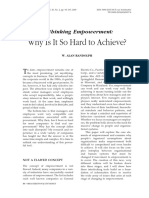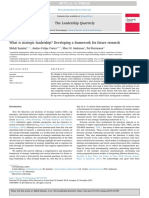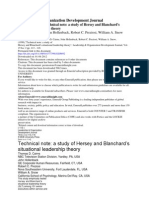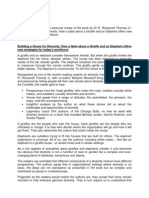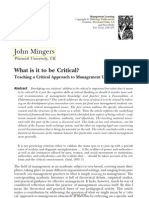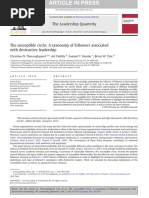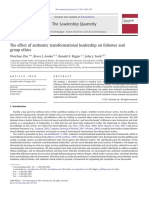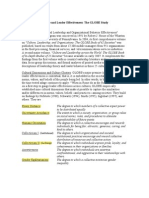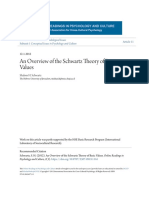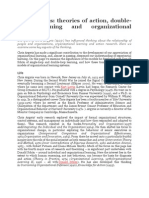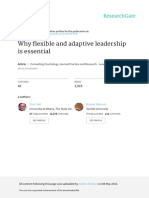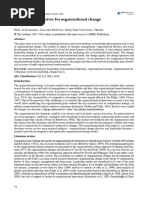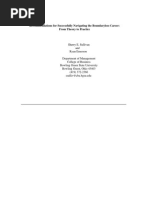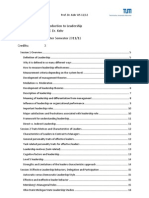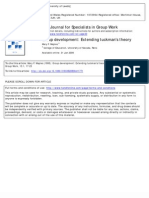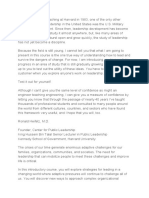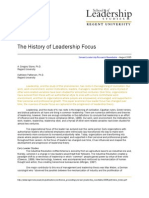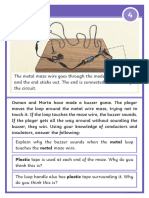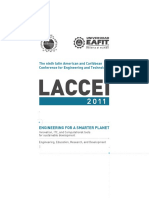Schyns & Schilling - A Meta-Analysis of Destructive Leadership A Its Outcomes
Schyns & Schilling - A Meta-Analysis of Destructive Leadership A Its Outcomes
Uploaded by
Vio NeaguCopyright:
Available Formats
Schyns & Schilling - A Meta-Analysis of Destructive Leadership A Its Outcomes
Schyns & Schilling - A Meta-Analysis of Destructive Leadership A Its Outcomes
Uploaded by
Vio NeaguOriginal Title
Copyright
Available Formats
Share this document
Did you find this document useful?
Is this content inappropriate?
Copyright:
Available Formats
Schyns & Schilling - A Meta-Analysis of Destructive Leadership A Its Outcomes
Schyns & Schilling - A Meta-Analysis of Destructive Leadership A Its Outcomes
Uploaded by
Vio NeaguCopyright:
Available Formats
The Leadership Quarterly 24 (2013) 138158
Contents lists available at SciVerse ScienceDirect
The Leadership Quarterly
journal homepage: www.elsevier.com/locate/leaqua
How bad are the effects of bad leaders? A meta-analysis of destructive
leadership and its outcomes
Birgit Schyns a,, Jan Schilling b
a
b
Durham University, UK
University of Applied Administrative Sciences, Hannover, Germany
a r t i c l e
i n f o
Article history:
Received 25 January 2012
Received in revised form 4 September 2012
Accepted 5 September 2012
Available online 28 September 2012
Keywords:
Leadership
Destructive leadership
Abusive supervision
Outcomes
Meta-analysis
a b s t r a c t
While the focus on constructive leadership still dominates leadership research, an increasing
number of studies investigate different forms of destructive leadership. This meta-analysis
integrates different conceptualizations of destructive leadership and analyzes the relationship
between destructive leadership and outcome variables. The search for articles yielded more
than 200 studies of which 57 could be included in the meta-analysis. Results indicate the
expected negative correlations with positive followers' outcomes and behaviors (e.g., attitudes
towards the leader, well-being, and individual performance) and positive correlations with
negative outcomes (e.g., turnover intention, resistance towards the leader, counterproductive
work behavior). As expected, the highest correlation arises between destructive leadership
and attitudes towards the leader. Surprisingly, the next highest correlation was found between
destructive leadership and counterproductive work behavior. After discussing the results, an
agenda for future research is proposed. Given the negative impact of destructive leadership,
more knowledge is especially necessary regarding what triggers destructive leadership.
2012 Elsevier Inc. All rights reserved.
1. Introduction
Traditionally, research into leadership has often been guided by the quest to find the most effective person or method to lead.
Popular concepts such as transformational leadership (e.g., Bass, 1985) but even more recent developments such as ethical (e.g., Brown,
Trevino, & Harrison, 2005) or authentic leadership (e.g., Walumbwa, Avolio, Gardner, Wernsing, & Peterson, 2008) focus on positive
leader behavior and its effects. Sometimes the term leadership is even limited to an exercise of personal influence resulting in
enthusiastic commitment of followers: proponents of this view argue that a person who uses authority and control over rewards,
punishments, and information to manipulate or coerce followers is not really leading them (Yukl & van Fleet, 1992: 148). However, a
recent stream of research (often under the label of supervision or supervisory behavior) acknowledges that there is also a dark side to
leadership (Conger, 1990): Regardless of what researchers and practitioners may consider ideal, some leaders behave in ways that are
detrimental to their followers and often the organization as a whole.
There are two main reasons for the growing interest in the dark side of leadership: First, there is the question of the prevalence of
and costs as a result of destructive leaders. While Aryee, Sun, Chen, and Debrah (2008) consider abusive supervision, as the one
concept that has dominated empirical research in this area, as a low base rate phenomenon (p. 394), other studies report a strong
prevalence of destructive leader behaviors in organizations. For example in the Netherlands, Hubert and van Veldhoven (2001) report
a prevalence rate of about 11%. Even higher prevalence rates have been found in a Norwegian study (Aasland, Skogstad, Notelaers,
Nielsen, & Einarsen, 2010) where about a third of employees report to have been subject to some type of destructive leadership
behavior often within the six months prior to the questioning. In the US, abusive supervision affects an estimated 13.6% of U.S.
workers (Tepper, 2007) at a cost of $ 23.8 billion annually for US-companies (e.g., due to employee absenteeism, employee turnover,
Corresponding author at: Durham Business School, Durham University, Mill Hill Lane Durham DH1 3LB, UK. Tel.: +44 191 334 5173; fax: +44 191 3345201.
E-mail address: birgit.schyns@durham.ac.uk (B. Schyns).
1048-9843/$ see front matter 2012 Elsevier Inc. All rights reserved.
http://dx.doi.org/10.1016/j.leaqua.2012.09.001
B. Schyns, J. Schilling / The Leadership Quarterly 24 (2013) 138158
139
and lowered effectiveness; Tepper, Duffy, Henle, & Lambert, 2006). These numbers underline the high practical importance of this
area of research.
The second reason for the interest in destructive leader behaviors stems from the findings that their effects on individual
followers are quite severe. A large variety of outcomes have been studied in relation to destructive leadership behaviors.
Examples include effects on job tension and emotional exhaustion (e.g., Harvey, Stoner, Hochwarter, & Kacmar, 2007), resistance
behavior (e.g., Bamberger & Bacharach, 2006), deviant work behavior (e.g., Duffy, Ganster, & Pagon, 2002), reduced family
well-being (e.g., Hoobler & Brass, 2006), and intention to quit and job satisfaction (e.g., Tepper, 2000). Both prevalence rates and
potential serious effects of destructive leader behaviors make it a concept worthwhile of deeper investigation.
While for some time, a lot of literature focusing on detrimental aspects of leadership was narrative in nature (e.g., Lipman-Blumen,
2004; Sutton, 2007), making quantitative research syntheses next to impossible, research in this area has now also attracted
substantial interest from quantitative researchers. Tepper (2007) stated in his qualitative literature review that most of the studies on
abusive supervision have been conducted during just the last few years. Thus, the time seems ripe for a meta-analysis, quantifying the
effect sizes that we can expect when leaders show destructive behaviors.
While meta-analyses already exist in the area of constructive leadership (i.e., Judge & Piccolo, 2004; Judge, Piccolo, & Ilies, 2004;
Wang, Oh, Courtright, & Colbert, 2011) as well as in the field of general workplace harassment/aggression (i.e., Bowling & Beehr,
2006), a comprehensive quantitative review of destructive leadership is still absent. To our knowledge, only Hershcovis (2011) has
undertaken such an endeavor. However, her intention was to meta-analytically compare supervisor-initiated aggression to other
constructs of workplace aggression. Hence, she does not give a full overview of the consequences of destructive leadership but rather
focuses on some outcome variables selected based on their usefulness for this comparison. Other meta-analyses have only focused on
specific aspects of destructive leadership (i.e., supervisor aggression, Hershcovis & Barling, 2010; non-contingent punishment,
Podsakoff, Bommer, Podsakoff, & MacKenzie, 2006).
In summary, while there is increasing evidence that destructive leaders cause serious problems for followers, organizations and
society, research in this area is lacking both an integration of the diverse concepts and a comprehensive, quantitative review of the
consequences of destructive leadership. Such a review will not only provide a state-of-the-art overview of our knowledge in this area
but also prospects for future theoretical and empirical developments. In fields of research like destructive leadership that are in a
relatively early stage, a major problem concerns the inconsistency of the terminology (cp. Tepper, 2007). Hence, we will start by
limiting the focus of our review by discussing the boundaries of destructive leadership and distinguishing it from the broader concept
of destructive leader behavior. We will then discuss the different constructs of destructive leadership used in previous research to
develop a definition and conclude which concepts we will include in our meta-analysis and why. Subsequently, we will briefly review
prior research in this area and derive assumptions regarding the relationship between destructive leadership and different outcomes,
before explaining how we conducted this meta-analysis and what the results were. We end with a discussion regarding what we
know about destructive leadership so far and directions for future research.
2. Distinguishing destructive leader behavior and destructive leadership?
It is not an easy task to define destructive leadership for two main reasons. First, as already mentioned, some researchers claim
that leadership can by definition only be positive (see Yukl & van Fleet, 1992). They reject the concept of destructive leadership as
being an oxymoron and advocate for different terms to capture the negative side of leader behavior (e.g., supervision, management, or
headship). Second, and perhaps as a consequence of this view, we see a rather scattered landscape of different terms, concepts, and
studies all interested in the dark side of leader behavior but with some important differences. Leadership researchers only recently
adopted the topic from other areas such as bullying and counterproductive work behavior (Tepper, 2007; Thoroughgood, Tate,
Sawyer, & Jacobs, 2012). It therefore seems necessary to answer two main questions: Why should we speak of leadership with respect
to the dark side of leader behavior? What exactly encompasses the term destructive leadership? To answer these questions, we first
need to establish a border between destructive leadership and the more general term of destructive leader behavior.
Thoroughgood and colleagues (2012) define destructive leader behavior as voluntary acts (committed by a person in a
leadership, supervisory, or managerial position) which most people would perceive as harmful and deviant towards followers
and/or the organization and which can either be physical or verbal, active or passive, direct or indirect. While others have made
similar distinctions (e.g. Einarsen, Aasland, & Skogstad, 2007), it seems important to us to note that Thoroughgood and colleagues
do not speak of destructive leadership but destructive leader behavior (unlike Einarsen et al., 2007). From our point of view, it is
important to acknowledge that while it is self-evident that not everything a leader does is leadership, the comprehensiveness of
the term destructive leadership is still debatable due to the difficulty of the term leadership itself. Yukl (2006) summarizes the
wide range of different definitions of leadership by stating that defining leadership is always to some degree arbitrary and
subjective. However, most definitions share the assumption that leadership involves a process whereby intentional influence is
exerted by one person over other people to guide, structure, and facilitate activities and relationships in a group and organization
(Yukl, 2006, p. 3). Hence, while destructive leader behavior can encompass a wider variety of harmful behavior which is not
related to the leadership task (e.g., taking drugs at work, stealing from the organization; cp. Thoroughgood et al., 2012), the term
of destructive leadership should be limited to those aspects which include follower-targeted influence (which is a key aspect in
defining leadership). In summary, we argue here that destructive leadership is not the same as destructive leader or supervisor
behavior as the latter refers to any type of negative behavior committed by a person in a leadership position, including
counterproductive work behavior. In this meta-analysis, we focus on leader behaviors that are targeted towards the followers
(and thus represent leadership) rather than the organization.
140
B. Schyns, J. Schilling / The Leadership Quarterly 24 (2013) 138158
3. Different conceptualizations and a denition: what is destructive leadership?
Even though concepts such as the negative side of charismatic leadership (often called personalized charisma, Howell, 1998) or
narratives about political leaders such as Hitler or Stalin (e.g., Burns, 2003; Kellerman, 2004) have been part of the leadership discussion
for a long time, the quantitative study of destructive leadership is a relatively recent one. Different conceptualizations of similar ideas
have emerged almost at the same time. Examples of such conceptualizations include abusive supervision (e.g., Tepper, 2000),
destructive leadership (Einarsen et al., 2007), toxic leadership (Lipman-Blumen, 2004), and petty tyranny (Ashforth, 1994). Table 1
gives an overview of the different types of destructive leadership found in the literature. There are a few key aspects in which the
definitions of these concepts differ which we will outline below.
(1) Perception versus actual behavior: As is the case with constructive leadership, destructive leadership tends to be assessed
from the followers' point of view. However, some definitions of the concepts included here explicitly refer to followers'
perception of the leader's behavior (e.g., abusive supervision: Tepper, 2000) whereas others only refer to the leader's
behavior (e.g., social undermining: Duffy et al., 2002). We argue that leader behavior can only have an effect when it is
perceived by followers and in that sense, probably all the different concepts of destructive leadership include an element of
perception.
(2) Intent: Another question is whether or not the behavior shown by the leader is intentionally or unintentionally destructive.
Some definitions of destructive leadership include the notion of intent (e.g., despotic leadership: De Hoogh & Den Hartog,
2008), other do not (e.g., petty tyranny: Ashforth, 1997) or do not do so explicitly (e.g., supervisor aggression: Inness,
Barling, & Turner, 2005). While it is quite difficult to empirically differentiate these different notions (see the discussion
between Hershcovis, 2011, and Tepper & Henle, 2011), some authors stress that the intent does not have to be real but that
the perception of intent is the key element here (e.g., social undermining: Duffy et al., 2002). We can assume that leader
behavior that is perceived to be intentionally destructive is more harmful than behavior that is unintentionally destructive
but both can be considered destructive.
(3) Physical, verbal, and non-verbal behavior: Destructive leadership can encompass a wide variety of behaviors, including
verbal and non-verbal behavior or even physical violence. While some definitions rule out physical behavior (e.g., Tepper,
2000), others include it in their definition (e.g., destructive leadership: Einarsen, Skogstad, Leseth, & Aasland, 2002). Even
though physical violence may be a rather unlikely form of destructive leadership, it seems advisable to not completely
exclude it from the definition in order not to limit the scope of destructive leadership too much in this early stage of
research.
(4) Inclusion of outcomes: Some definitions of destructive leadership explicitly refer to outcomes (e.g., Einarsen et al., 2002),
others define the concept in more neutral terms (e.g., petty tyranny: Ashforth, 1997). An interesting discussion can be
undertaken regarding the question as to whether or not the conceptualization of destructive leadership should refrain from
including references to outcomes. On the one hand, a more neutral approach to assessing leaders' destructive behavior
would be useful as, otherwise, testing correlations between the construct and its potential outcomes can be redundant. On
the other hand, practically it can be difficult to differentiate destructive behavior from the destructiveness regarding its
outcomes. We follow the arguments of Thoroughgood and colleagues (2012) in that we focus on the perceived nature of
the target behavior rather than on its specific consequences as this may lead to the incorrect inclusion or exclusion of
certain behaviors.
Table 1
Types of destructive leadership used in the studies included in the meta-analysis and articles that introduced the concept.
Type of destructive
leadership
Petty tyranny
Abusive supervision
Coercive power
Abusive supervisory behaviors
Social undermining
Supervisory abuseb
Supervisor verbal abuse
Unsupportive managerial behaviors
Aversive leadership
Destructive leadership
Tyrannical leadershipd
Despotic leadership
Articles that introduced the
concept
Ashforth (1997)
Tepper (2000)
Elangovan and Xie (2000)
Yagil (2005)
Duffy et al. (2002)
Bamberger and Bacharach (2006)
Grandey et al. (2007)
Rooney and Gottlieb (2007)
Bligh et al. (2007)
Einarsen et al. (2002)
Hauge et al. (2007)
De Hoogh and Den Hartog (2008)
Perception (Perceived) Duration/ Physical, verbal, and Target Inclusion of
Intent
frequency non-verbal behavior
outcomes
N
Y
N
Y
N
Y
N
N
Y
N
Y
N
N
N
N
N
Y
Y
Y
Y
Y
Y
Y
Y
Y
Note: N = No; Y = Yes; V = Verbal; NV = Nonverbal; P = Physical; F = Follower; O = Organization; C = Colleagues.
a
In our meta-analysis, only supervisor behavior towards followers is included.
b
Definition based on Tepper but different instrument used. We assume the same characteristics as valid for Tepper.
c
Only follower related behavior is included in our meta-analysis.
d
This is part of the destructive leadership model by Einarsen et al. (2002) and therefore follows the same definition.
e
Only follower related behavior is included in our meta-analysis.
V/NV
V/NV
F
F
V/NV
V/NV
V/NV
V
V/NV
V/NV
V/NV/P
V/NV/P
V/NV/P
F
F/Ca
F
F
F
F
F/Oc
F/Oe
F/O
N
N
Y
N
Y
N
N
N
N
Y
Y
N
B. Schyns, J. Schilling / The Leadership Quarterly 24 (2013) 138158
141
Following this summary and consistent with the definition of leadership by Yukl (2006), we will define destructive leadership
as a process in which over a longer period of time the activities, experiences and/or relationships of an individual or the members of a
group are repeatedly influenced by their supervisor in a way that is perceived as hostile and/or obstructive. Some aspects of this
definition deserve further explanation.
(1) Influence: Exerting influence on followers is at the heart of most of the definitions of leadership (Yukl, 2006), which makes
it also a key feature of destructive leadership. This means that a leader uses destructive leadership to achieve a certain aim
and at least unintentionally (see discussion above) influences the activities and relationships within the group.
(2) Supervisor: While many definitions of leadership in general do not define who exerts the influence, a definition on
destructive leadership needs to be clear about this aspect and focus on hierarchical mistreatment (cp. Tepper, 2007). While
not impossible, it seems rather unlikely that a person without formal authority can emerge and stay in a position of an
informal leader in an organizational context by behaving destructively (at least in the long run). Many conceptions of
destructive leader behavior include the abuse of formal power as an important means to intimidate and punish reluctant
followers.
(3) Repetition over a longer period of time: To qualify as destructive leadership, it seems also important that the negative influence
on the group members is exerted not just once or twice but repeatedly over a longer period of time. This aspect roots deeply in
the literature on workplace bullying (e.g. Einarsen, Hoel, Zapf, & Cooper, 2003) as it is important to distinguish destructive
leadership from short-term conflicts or single destructive acts. It has to be stressed that a boss who has a bad day and takes it
out on his or her followers should not be considered as a destructive leader (Tepper, 2007).
(4) Perceived hostility and/or obstructiveness: As stated before, destructive leadership should be defined by the nature of the target
behavior rather than its consequences (Thoroughgood et al., 2012). Hence, the core of destructive leadership lies in the hostile
and hindering nature of the leader's behavior. While constructive leadership is defined as reaching common agreements about
work and facilitating individual and collective efforts to achieve shared goals (cp. Yukl, 2006), destructive leadership on the
contrary involves hostile behavior (like public ridiculing, taking credit for subordinates' successes, and scapegoating
subordinates; Keashly, Trott, & MacLean, 1994) as well as impeding cooperative work in the team (like giving someone the
silent treatment and prohibiting interaction with coworkers; Tepper, 2000). As stated above, it is important to note that
hostility and obstructiveness can only be subjective evaluations subordinates make on the basis of their observations of their
supervisors' behavior (Tepper, 2007, p. 4).
(5) Individual or group: There is an ongoing discussion about the level of analysis in leadership research (see, e.g., Yammarino,
Dionne, Chun, & Dansereau, 2005). Some conceptualizations of leadership explicitly refer to the individual level relationships
(e.g., LeaderMember Exchange; Graen & Uhl-Bien, 1995) whereas others imply group level relationships (i.e., the leader
behaves the same towards all members of his/her group, e.g., transformational leadership: Bass, 1985). We assume that
destructive leadership can refer to both levels, in the sense that leaders might target only one or few members of their group,
and/or only one or few members of their group perceive destructive leadership, or they are generally destructive towards all of
their followers.
4. Sharpening the focus: what is not destructive leadership?
An important issue raised by this definition of destructive leadership is the question as to whether or not laissez-faire
leadership (non-leadership) can be included as a type of destructive leadership. Skogstad, Einarsen, Torsheim, Aasland, and
Hetland (2007) argue in this direction and state that destructive leadership can take both active, manifest as well as passive,
indirect forms. Skogstad and colleagues (2007) underline that not only the direct forms of supervisor hostility but also a lack of
initiative and support can have negative effects on subordinates' satisfaction and performance. This argument is supported by
their own empirical results (i.e., laissez-faire leadership is related to higher levels of role conflict, role ambiguity, and conflict
with co-workers; Skogstad et al., 2007) as well as those of others (e.g., Judge & Piccolo, 2004).
However, as a concept should not be defined by its consequences (see above), the question remains if the term destructive is
really appropriate when talking about laissez-faire leadership. Padilla, Hogan, and Kaiser (2007) note that destructive leadership
results in harmful, long-term ramifications. The very broad conception by Skogstad and others (2007) may blur important
differences within the field of the dark side of leadership. While it is certainly true that laissez-faire is an ineffective leadership
style (i.e., inappropriate to achieve follower satisfaction and effective performance), we see a clear qualitative difference between
non-leadership and active supervisor hostility as described by the concepts such as abusive supervision (Tepper, 2000) or petty
tyranny (Ashforth, 1994). The latter can be expected to have much more severe and potentially even qualitatively different
detrimental consequences (for a similar argument see Ashforth, 1994).
An even more difficult aspect of the dark side of leadership is the so-called supportive-disloyal leadership (Einarsen et al., 2007)
which is described as showing (too much) consideration for the welfare of followers while violating organizational goal attainment.
Such leaders may steal resources from the organization, protect their followers from work, and grant their employees more benefits
than they are obliged to (Einarsen et al., 2007). The difficulty with this concept is that this kind of leadership is normally not regarded
as hostile by the followers as they may benefit from it (at least in the short run). While there can be no doubt that it is a destructive
leader behavior with regard to the organization, supportive-disloyal can be expected to produce quite different reactions on part of the
followers than other forms of destructive leadership such as abusive supervision or tyrannical leadership (see Einarsen et al., 2002).
142
B. Schyns, J. Schilling / The Leadership Quarterly 24 (2013) 138158
Therefore, it should be treated as a separate area of destructive leader behavior in order not to blur the important differences between
these concepts.
In summary, it now seems necessary to distinguish between destructive and negative leadership (cp. Schilling, 2009). In
contrast to our definition of destructive leadership, negative leadership is used as an overarching term including commonly
disliked and denounced behaviors ranging from ineffective (such as laissez-faire leadership) and anti-organizational behavior
(such as supportive-disloyal leadership) to destructive aspects in the sense of our definition (cp. Kellerman, 2004).
In conclusion, in our definition of destructive leadership, we are inclusive in the sense that we include as many concepts as possible
without blurring the concept. Other than excluding non-leadership (laissez-faire) and supportive-disloyal leadership for the reasons
indicated above, we therefore decided to include a broad range of behaviors in our definition. Thus, we include verbal, non-verbal, and
physical behavior as part of destructive leadership. With respect to the target of the behavior, we decided to focus on the follower as a
target. The reason, as indicated above, is related to the question of leadership versus general destructive leader behavior. In our
meta-analysis, we were not so much interested in leaders' general misbehavior (which could also include, e.g., counterproductive
work behavior) than in leadership behavior directed towards the followers.
5. Destructive leadership and outcomes: theoretical framework
Conducting a meta-analysis means that in terms of the constructs examined, we have to rely on research that has been conducted
so far in the area for the selection of outcome variables. In reviewing the relevant literature in the field, we found that most of the
outcomes of destructive leadership are assessed from a followers' point of view. Theoretically, and in line with our definition of
destructive leadership, focusing on follower-related outcomes makes sense, as part of our definition is that destructive leadership is
focused on influencing followers. As we outlined above, this is different from general destructive leader behavior as defined by
Thoroughgood and colleagues (2012). The latter also refers to destructive behavior against the company, meaning that a different set
of outcomes might be more relevant.
Outcomes under study in the area of destructive leadership can broadly be differentiated into leader-related concepts, job-related
concepts, organization-related concepts, and individual follower-related concepts (see Fig. 1). While there are certainly outcomes
that can be classified under several of these categories, we broadly used the following guidelines of categorization: Probably the
easiest category to define is leader-related concepts. Here, we subsumed concepts that related directly to the leader such as follower
resistance towards the leader (e.g., Bligh, Kohles, Pearce, Justin, & Stovall, 2007) and leader identification (Ashforth, 1997). These are
dyadic concepts, in the sense that they are attitudes or behaviors shown by individual followers to individual leaders. One of the main
concepts categorized as job-related is job satisfaction (e.g., Tepper, 2000). While different conceptualizations can comprise different
aspects of job satisfaction (e.g., the supervisor or the organization), we argue that job satisfaction a) is often assessed with one
question (Wanous, Reichers, & Hudy, 2000) relating directly to the job or b) assesses different facets that make up a job. Where
specific aspects were differentiated (e.g., the supervisor), these were summarized under the respective other category (in this
example, attitudes towards the leader).
Organization-related concepts comprise concepts that directly affect the organization such as organizational commitment or
turnover. While one could argue that these concepts are influenced by a myriad of antecedents and also do not only affect the
organization (e.g., people who leave the organization also leave their supervisor and their team), it seemed most appropriate to
summarize them under organization-related concepts as they convey an attitude towards the organization as a whole.
We summarized stress, well-being, and performance under individual follower-related concepts as they are consequences that relate
to the individual follower. Arguably, performance is broader and relates to the job as well as the organization, however, we categorized
this variable as individual follower-related concept in order for it not to be confused with performance of the organization as a whole.
In the following, we will outline the expected relationships between destructive leadership and those outcomes as well as how
we think the relationships will differ from each other with respect to their strength. We will also discuss differences in the effect
sizes between destructive and constructive leadership.
Fig. 1. Outcomes of destructive leadership.
B. Schyns, J. Schilling / The Leadership Quarterly 24 (2013) 138158
143
5.1. Leader-related concepts
Several studies have looked into leader-related concepts, mainly follower resistance towards the leader (e.g., Bligh et al., 2007)
and attitudes towards the leader (e.g., leader identification; Ashforth, 1997). The assumption is that followers show resistance
towards destructive leaders. Tepper, Duffy, and Shaw (2001) argue that resistance such as ignoring request can be a way of frustrating
leaders in a way that is somewhat ambiguous from the target's perspective in terms of intent (p. 975) and thus a good way to
retaliate to leaders. Their results confirm that abusive supervision is positively related to resistance. With respect to attitudes towards
leaders, an example is Duffy and Ferrier's (2003) study examining trust in the supervisor. They argue that abusive supervision should
lower trust in the supervisor and indeed found empirical support for this hypothesis. On a more general level, it is likely that followers
change their attitudes and behaviors towards the source of destructive behavior, that is, their leader. Based on the available theory
and results, we assume:
H1. Destructive leadership will have negative relationships with positive leader-related concepts (such as trust) and positive
relationships with negative leader-related concepts (such as resistance).
5.2. Job-related concepts
In the context of destructive leadership, the concept most examined is job satisfaction. Many studies argued and found that
destructive leadership is negatively related to job satisfaction (e.g., Tepper, 2000; Tepper, Duffy, Hoobler, & Ensley, 2004) as
supervisors form a significant part of one's job and, thus contribute to making a job a pleasant or unpleasant experience. Part of
destructive leadership is putting forwards unreasonable demands or ridiculing followers, which are behaviors that make the daily
experience of going to work displeasing. Other job-related attitudes under investigation were job dedication (Aryee et al., 2008) and
work motivation (Elangovan & Xie, 2000). Being dedicated to a job that involves destructive leader behavior is likely to be difficult,
even if the follower is dedicated to his/her profession in general. The same is true for motivation: Keeping up motivation in the light of
abuse is unlikely in the longer run. Again, the assumption that destructive leadership is negatively related to these concepts was
generally supported. Given prior theory and results we assume:
H2. Destructive leadership will have negative relationships with positive job-related concepts and positive relationships with
negative job-related concepts.
5.3. Organization-related concepts
Organization-related concepts that have been examined in prior research include turnover intention (Ashforth, 1997),
counterproductive work behavior (Mitchell & Ambrose, 2007), justice (Zellars, Tepper, & Duffy, 2002), and commitment
(Burris, Detert, & Chiaburu, 2008). Regarding turnover intention, Ashforth (1997) found that petty tyranny is positively related
to turnover intention. He argues that this is due to the unpredictability of petty tyrants which creates work alienation. Mitchell
and Ambrose (2007) argue that in addition to direct retaliation to the supervisor, followers of abusive leaders will also show
what they call displaced deviance towards the organization. Their results support this assumption. With respect to justice,
Tepper (2000) argues that followers of abusive supervisors will perceive his/her behavior as unjust and thus evaluated
procedural justice as low. This notion was supported in his study. Arguably, commitment to an organization that allows
destructive leadership should be low as followers might think that the organization fails to protect them. This notion was
empirically supported (e.g., Burris et al., 2008).
H3. Destructive leadership will have negative relationships with positive organization-related concepts and positive relationships
with negative organization-related concepts.
5.4. Individual follower-related concepts
Outcomes of destructive leadership on individual followers examined in prior research include affectivity, stress, well-being,
and performance. In the context of abusive supervision and outcomes, affectivity is often used as a control variable (e.g., Breaux,
Perrewe, Hall, Frink, & Hochwarter, 2008). Destructive leadership is often found to be positively related to negative affectivity
(e.g., Tepper et al., 2004) and negatively related to positive affectivity (e.g., Wu & Hu, 2009). Technically, affectivity could also be
an antecedent of destructive leadership, as people might differ in how they evaluate a leader's behavior based on their general
affectivity. Stress and well-being are probably the most examined outcomes of destructive leadership, as it almost seems a
matter of course that destructive leadership is positively related to stress and negatively related to well-being. Long-term and
frequent exposition to destructive behavior from a person that is in charge is likely to cause stress and lead to lower well-being.
Sample studies examining stress are Chen and Kao (2009) and Tepper (2000) and for well-being Hobman, Restubog, Bordia, and
Tang (2009) and Burris and colleagues (2008). Results for the relationship between destructive leadership and individual
performance tend to support the notion that destructive leadership is negatively related to performance (e.g., Aryee, Chen, Sun,
and Debrah (2007)). Theoretically, there are different reasons to assume that destructive leadership is likely to have an impact
144
B. Schyns, J. Schilling / The Leadership Quarterly 24 (2013) 138158
on individual performance: First, followers may lower their efforts in the face of a destructive leader. Second, negative
relationships between destructive leadership and motivation or well-being could explain why the performance of followers of
destructive leaders is low.
H4. Destructive leadership will have negative relationships with positive individual follower-related concepts and positive
relationships with negative individual follower-related concepts.
5.5. Strength of relationships
Looking at the different relationships outlined above, we can assume that not all of them will be of the same strength. In terms
of the size of effects, we can assume that attitudes and behaviors that are directed towards the destructive leader would be more
strongly related to destructive leadership than relationships to job- or organization-related attitudes and behaviors. Attitudes
towards the source of the negative experiences and direct retaliation are likely to be influenced solely by the leader whereas
other attitudes and behaviors are influenced by other sources as well.
H5. The effect sizes found for the relationships between destructive leadership and leader-related attitudes and behaviors will be
higher than those for job- or organization-related attitudes and behaviors.
5.6. Destructive and constructive leadership
Based on Baumeister, Bratslavsky, Finkenauer, and Vohs (2001), Einarsen and colleagues (2007) assume that destructive
leadership has stronger effects than positive leadership. While it is beyond the scope of this meta-analysis to directly compare
effects of destructive and constructive leadership, we will examine the size of the effects of destructive leadership on various
outcome variables and compare our results to prior meta-analyses on constructive leadership. In line with Baumeister and
colleagues (2001) and Einarsen and colleagues (2007), we argue that negative behavior should have stronger effects than positive
behavior. Thus:
H6. The effect sizes found for the relationships between destructive leadership and follower attitudes and behaviors will higher
be than those for constructive leadership and follower attitudes and behaviors.
6. Method
6.1. Search strategy and inclusion/exclusion criteria
In order to identify articles to be included in the meta-analysis, we used three approaches (following procedures of other
meta-analyses; cp. Judge & Piccolo, 2004; Judge, Colbert, & Ilies, 2004; Hershcovis & Barling, 2010). First, we reviewed the reference
list of Tepper's (2007) overview article. Second, we conducted a literature research in PsycINFO, Google Scholar, and Web of Science to
identify further studies. As there is at this stage not a unitary term in use for destructive leadership, we used a variety of search terms,
such as abusive supervision, abusive leadership, destructive supervision, and destructive leadership. We restricted our search to
keywords, title, and abstract. The cut-off date for this search was end of September 2010. Table 2 depicts the search terms used and
the number of articles found for each of those terms. Third, we also contacted colleagues working and publishing in this field on an
individual basis to uncover some unpublished research.
Using all search strategies outlined above, we found 260 articles. The PsycINFO search yielded 104 studies. All other searches
combined yielded another 156 articles.
We used several strategies to identify studies relevant for our meta-analysis. First, we reviewed the abstracts of the articles
found. Based on the criteria outlined below, we discarded 44 articles after reading the abstracts. In the second stage, we
reviewed the remaining 216 articles. Of those articles, 61 were deemed relevant, 152 were not relevant, and 3 were not
available. Reasons for non-inclusion in our meta-analysis were: The articles reported no quantitative data (e.g., review or
theoretical articles as well as qualitative papers were excluded), the study did not refer to hierarchical relationships (e.g., some
studies referred to peer, rather than leadership behavior), the study did not use behavior as a unit of measurement (e.g., some
studies focused on traits), the study did not take place in a formal work context (e.g., some studies comprised samples in
mentoring relationships), the article was not written in English, the study did not include a form of destructive leadership (see
above, we excluded studies that used laissez-faire leadership as a form of destructive leadership), or the study did not refer to
personal leadership (e.g., some studies comprised structural or HRM type of leadership). We also excluded studies that did not
differentiate the perpetrator of the negative behavior (e.g., some studies focus on workplace aggression in general
independent of who shows the aggression, e.g., some studies reported in Hershcovis, 2011). Finally, some articles did not
contain enough information to be included in our meta-analysis. We also excluded articles that reported on the same data set
for a second time.
B. Schyns, J. Schilling / The Leadership Quarterly 24 (2013) 138158
145
Table 2
Search terms and number of articles found in PsycINFO.
Search term
Abusive supervision
Supervisor abuse
Abusive leadership
Bossing
Despotic leadership
Despotic supervision
Destructive leadership
Destructive supervision
Narcissistic leadership
Narcissistic supervision
Negative leadership
Negative supervision
Petty tyranny
Psychopathic leadership
Psychopathic supervision
Toxic leadership
Toxic supervision
Tyrannical leadership
Tyrannical supervision
Total N of articles found in PsycINFO
Number of articles found
46
1
1
9
2
0
11
0
4
0
13
7
2
1
0
4
0
2
1
104
6.2. Coding procedure
For all studies relevant to our meta-analysis, we identified the measurement of destructive leadership used. Table 1 gives an
overview of the concepts used in the studies included in the meta-analysis and the article that introduced the concept. We did not
further exclude studies here but rather included all studies satisfying our criteria outlined above. While this led to the inclusion of a
variety of different assessments of destructive leadership, they all share a common core reflecting our definition of destructive
leadership. From the different kinds of measurement, the abusive supervision scale (Tepper, 2000) was by far the most often used
instrument. While the majority of studies (Brown et al., 2005) used the full 15-item version, some studies (Baumeister et al., 2001)
used shorter versions ranging from 3 to 13 items taken from Tepper (2000) (see Appendix A). Three studies combined some of
Tepper's items with those of other scales to measure abusive supervision.
Next, we identified all other variables included in each of the studies. Due to the focus of our study, we only included outcome
variables (i.e., variables that may actually be affected by destructive leadership). Hence, demographic variables and follower
personality were not incorporated into our analyses.
We then examined in how far studies used the same correlates of destructive leadership so that a meaningful meta-analysis
of the respective relationships could be undertaken. Wherever possible, based on the number of studies using the same
construct, we analyzed studies using the same construct (e.g., job satisfaction). However, as the outcomes were quite varied, we
categorized them so that more studies could be included in each meta-analytic calculation of relationships. To achieve this,
qualitative content analysis was chosen as an approach that combines the strengths of the grounded theory approach in the
discovery of natural categories with strategies from traditional content analysis (cp. Schilling, 2006). This included the basic
processes of comparing the outcome variables and their constituting (sample) items found in the studies to develop categories.
The first step was to find simple categories based on the constructs found in the different studies. Most outcome variables could
be coded on the basis of their name as they were used in enough studies (e.g., positive affectivity, affective commitment, and job
satisfaction). As a rule of thumb we created an outcome category if a variable was used in at least six different studies (cp. Locke,
2002). The second step was to analyze the rest of the variables to find commonalities in order to combine small categories
(subsuming old or formulating new categories; Conger, 1998). For example, we defined a category follower resistance towards
leader which included variables such as leader-directed deviance, aggression, and retaliation; that is, variables which shared
the idea of negative behavior towards the (destructive) leader. The two categories well-being and organizational
performance were kept as first-order categories of outcome variables even though they comprised less than six studies as
they could not meaningfully be combined with other outcome variables. Finally, we structured the thus established category
system by subsuming the categories to four higher level groupings based on their focus (leader, job, organization, and individual
follower). This categorization was conducted in line with our theoretical considerations outlined under Destructive leadership
and outcomes: theoretical framework. Table 3 depicts all categories used and gives examples of the concepts that were
summarized under each category.
For 2/3 of the articles, two raters conducted the categorization of the outcome criteria jointly. The codes were discussed and a
coding scheme developed and applied. For the remaining 1/3 of the articles, two raters independently coded the variables with regard
to the category system outlined above. A computation of the inter-rater-reliability for the categorized outcome variables used in these
studies yielded a value of .90 (Cohen's kappa), which signifies high inter-rater agreement.
For all relevant studies, the correlations between destructive leadership and outcomes were extracted. Appendix A1 indicates the
studies that were used for each of the correlations. The numbers vary considerably as some outcomes were studied more commonly
146
B. Schyns, J. Schilling / The Leadership Quarterly 24 (2013) 138158
Table 3
Categories used in the meta-analysis.
Category
Leader-related concepts
Follower resistance towards leader
Attitudes towards leader
Job-related concepts
Job satisfaction
Job-related attitudes
Organization-related concepts
Turnover intention
Counterproductive work behavior
Justice
Organizational performance
Commitment
Individual follower-related concepts
Affectivity
Positive self-evaluation
Follower stress
Follower well-being
Individual performance
Sample concepts
Aggression, supervisor-directed deviance
Trust, liking
Job satisfaction
Dedication, involvement, motivation
Intention to turnover, intention to quit
Organizational deviance, counter-productive behavior at work
Distributive justice, pay fairness, procedural justice
Affective commitment, organizational commitment
Positive affectivity, negative affectivity
Self-esteem, core self-evaluation, self-efficacy
Exhaustion, depression
Life-satisfaction, physical well-being
OCB, performance, work effort
than others. Overall, 57 articles (some reporting more than one study) reported relevant results and all necessary information to be
included in our meta-analyses.
6.3. Analyses
We used the program Comprehensive Meta-Analysis (Borenstein, Hedges, Higgins, & Rothstein, 2005) to conduct our metaanalyses. For each category of outcomes, we conducted a separate analysis. Where several correlations between the same constructs/
outcome categories were reported in one study, we used several approaches to including them in our meta-analysis: First, if the
correlations were independent (e.g., the same relationships were reported for different samples), we treated them as independent,
including all relevant correlations in our analyses. Second, where dependent correlations were reported, for example, between
several types of destructive leadership and the same outcome, or between destructive leadership and outcomes that were coded into
the same category, we averaged the correlations. While there are different methods to correct these average correlations, most of
them tend to lead to higher estimates of correlations (Hunter & Schmidt, 2004). Using the average therefore constitutes a
conservative estimate of the overall correlation. Given that we assumed we would find relatively large effects and given also the
possible practical implications of over-estimating effect sizes, we decided to use a conservative estimate.
We conducted all analyses twice, once with the raw correlations and a second time with the corrected correlations (corrected for
unreliability where this information was available in the primary studies). We will, however, interpret only the meta-analytic results
of the raw correlations as the corrected correlations constitute the upper limit of the estimation of the population correlation and,
given we expect large effects, we decided to follow a conservative estimation in order not to exaggerate the effects of destructive
leadership.
7. Results
Table 4 depicts the results of our meta-analyses. The results are very much in line with our expectations, showing that
destructive leadership is negatively related to positive leader-related concepts and positively related to negative leader-related
concepts, thus supporting H1. As we only found studies examining positive job-related attitudes to include in our meta-analyses,
we can only in part support H2 in so far as destructive leadership is negatively related to positive job-related concepts. We
assumed in H3 that destructive leadership will have negative relationships with positive organization-related concepts and
positive relationships with negative organization-related concepts. Our results support this hypothesis. We also found support for
H4 (Destructive leadership will have negative relationships with positive individual follower-related concepts and positive
relationships with negative individual follower-related concepts), although the relationship between destructive leadership and
positive affectivity was rather low. For all results it has to be noted, however, that the variance within the studies (Qwithin) is often
large, indicating heterogeneity of results.
As expected in Hypothesis 5, the strongest effects we found were for attitude towards the leader, indicating that destructive leader
behavior is directly related to how followers feel about their leader. However, the relationship between destructive leadership and
follower resistance (towards the leader), while still a strong effect and in the expected direction, is weaker than some of the other
relationships, indicating that attitudes maybe more strongly affected by destructive leadership than behavior, at least where the
leader is directly concerned.
B. Schyns, J. Schilling / The Leadership Quarterly 24 (2013) 138158
147
Table 4
Outcomes of meta-analysiscorrelations between destructive leadership and outcomes.
Concept
Leader-related concepts
Follower resistance (overall)
Abusive
Other
Attitude towards leader (overall)
Abusive
Other
Job-related concepts
Job satisfaction (overall)
Abusive
Other
Job-related attitudes (overall)
Abusive
Other
Organization-related concepts
Turnover intention (overall)
Abusive
Other
Counterproductive work behavior (overall)
Abusive
Other
Justice (overall)
Abusive
Other
Organizational Performance
Commitment (overall)
Abusive
Other
Individual follower-related concepts
Affectivity
- Positive affectivity (overall)
Abusive
Other
- Negative affectivity (overall)
Abusive
Other
Positive self-evaluation (overall)
Abusive
Other
Stress (overall)
Abusive
Other
Well-being (overall)
Abusive
Other
Individual performance (overall)
Abusive
Other
Qb
7.770
14.306
37.620
2.189
59.872
23.352
18.068
5.540
0.068
13.564
4.982
32.089
28.188
2.011
CI
Qw
Lower limit
Upper limit
8
6
2
7a
2
4
2176
1637
539
1582
192
720
.295
.263
.387
.571
.521
.511
.256
.217
.313
.604
.618
.563
.333
.308
.457
.537
.408
.454
21a
10
10
6
2
4
8707
2724
5313
2784
501
2283
.336
.272
.347
.319
.263
.330
.355
.307
.370
.352
.343
.366
.317
.237
.323
.285
.180
.293
11a
5
5
19a
13
5
12
11
1
2
14
10
4
6034
2440
2924
7610
5219
1721
4625
2965
1660
333
3821
3033
788
.313
.222
.339
.377
.395
.292
.321
.278
.393
.039
.212
.194
.283
.290
.184
.306
.358
.372
.248
.346
.311
.433
.069
.242
.228
.346
.335
.260
.371
.397
.418
.334
.294
.244
.352
.146
.182
.159
.217
8
5
3
15
10
5
13
7
6
24
12
12
4
3
1
12
7
5
2514
1839
675
6860
4881
1979
2856
1504
1352
12,093
3836
8258
1057
990
67
4657
1946
2711
.094
.097
.085
.339
.364
.276
.172
.211
.129
.243
.314
.210
.346
.366
.010
.204
.180
.221
.133
.142
.160
.318
.339
.234
.208
.259
.181
.226
.285
.189
.398
.419
.250
.231
.223
.256
.055
.051
.009
.360
.388
.316
.136
.161
.076
.259
.343
.230
.291
.311
.231
.176
.136
.184
131.773
10.050
7.106
27.611
45.372
9.521
1.684
33.536
13.594
32.213
127.898
20.158
57.352
0.000
31.018
14.916
2.324
24.486
97.350
6.373
51.430
22.861
55.980
91.769
28.188
0.000
11.012
17.095
other refers to studies that used instruments other than abusive supervision.
p b .05.
p b .001.
a
Where a study used both abusive supervision and another instrument, the correlations reported in this study were averaged and included in the overall
calculation but deleted from the moderator analysis.
The second strongest effect (though much smaller than the one for leader-related attitudes) emerged for counterproductive work
behavior. This shows the wider effects of destructive leadership, in the sense that more general job-related behaviors are affected by
destructive leadership behavior. While direct resistance towards the leader contains a greater risk of punishment by the leader,
general counterproductive work behavior may be a safer (i.e., more clandestine) way to retaliate upon one's leader for his destructive
leadership.
Job-related concepts such as job satisfaction and organization-related concepts such as turnover intention and the experience of
justice also showed medium-sized correlations to destructive leadership although interestingly not as high as counterproductive work
behavior.
148
B. Schyns, J. Schilling / The Leadership Quarterly 24 (2013) 138158
As expected well-being, negative affectivity, and stress were found to be related to destructive leadership, indicating that this type
of leader behavior has effects that are wider than just work-related. The relationship with occupational stress is not as strong as those
for the two other variables. This may be a hint that an impairment of one's personal well-being and the experience negative emotions
are more strongly affected by destructive leadership while occupational stress is influenced by other factors (e.g., the availability of
coping resources). The experience that colleagues are exposed to the same kind of destructive leader behavior may work as a
moderator in this relationship resulting in lower levels of stress (i.e., a problem shared is a problem halved). We also found smaller
but significant effects for organizational commitment, follower positive self-evaluation, and individual performance. These concepts
are clearly influenced by a wider range of factors outside the leader's control but it is still striking that destructive leadership has an
effect even on those aspects of their followers' lives.
As abusive supervision was the most often used concept in the studies we found, we compared the correlations between studies
using the instrument assessing abusive supervision introduced by Tepper (2000) and outcomes, on the one hand, and studies using a
different instrument to assess destructive leadership (e.g., petty tyranny) and outcomes, on the other hand. The results are depicted in
Table 4. At first glance the pattern of results of the moderator analysis does not seem to be very clear. However, looking a bit more
closely, it seems that abusive supervision yields higher correlations than other instruments for more personal concepts such as
affectivity and well-being. It is also more strongly related to attitudes and behavior directed towards the leader and CWB. In studies
using instruments other than Tepper's questionnaire, we found higher correlations with outcomes such as resistance, turnover
intention, justice, and performance. These seem to be more directly related to the job than the outcomes abusive supervision is more
highly related to. Although this is speculation, we can assume that the reason for these differences is due to item contents: Reviewing
the items of the abusive supervision instrument by Tepper in comparison to those of the other instruments, abusive supervision may
have a stronger personal connotation as some of the behaviors listed seem less work-relevant than behaviors subsumed under other
concepts. That means that the differences in correlations could be due to specificity matching (Brunswick, 1956).
We also compared our results to meta-analyses of constructive leadership. We assumed (Hypothesis 6) that the effect sizes found
for the relationship between destructive leadership and follower attitudes and behaviors will be higher than those for constructive
leadership and follower attitudes and behaviors. We selected the meta-analyses to compare our results to on the basis that (a) they
report meta-analytic results of a constructive leadership concept (e.g., transformational leadership, LMX), (b) they include one or more
outcomes that were included in our meta-analysis, and (c) they were not integrated in newer meta-analyses (e.g., Judge & Piccolo, 2004,
integrated the older meta-analyses of Lowe, Kroeck, & Sivasubramaniam, 1996; Fuller, Patterson, Hester, & Stringer, 1996). We found
these meta-analyses using PsycINFO and the search terms meta-analysis and leadership.
As shown in Table 5, the pattern of results for destructive versus constructive leadership is slightly mixed. Most of the correlations are
higher for constructive rather than destructive leadership with the exception of commitment and well-being. Interestingly, the pattern
of results is different for different constructive leadership concepts: For the constructive leadership concepts LMX and transformational
leadership all correlations are higher than those for destructive leadership. Thus, our sixth hypothesis was not supported.
8. Discussion
The aim of this meta-analysis was to summarize quantitatively the relationships that destructive leadership has with leaderrelated, job-related, organization-related, and more general person-related outcomes. One of the most interesting results of our
meta-analysis is the fact that the pattern of results is not only as expected but also how narrow the confidence intervals are. This means
that we can be rather confident in drawing conclusions about the expected strength and direction of the relationships between
destructive leadership and outcomes. As expected, the results were strong for the outcomes related to the supervisor him/herself.
Followers of destructive leaders are likely to have negative attitudes towards the leader and show resistance towards her/him. Indeed,
Table 5
Outcomes of destructive and constructive leadership.
Outcome
Destructive
leadership
Constructive
leadership
Concept
Source for constructive
leadership
Attitude tow./satisfaction with
leader
.57
Job satisfaction
.34
Turnover intention
Commitment
Well-being
.31
.21
.35
.68
.27
.62
.71
.55
.40
.19
.46
.23
.58
.64
.28
.35
.26
Consideration
Initiating structure
LMX
Transformational leadership
Contingent reward
Consideration
Initiating structure
LMX
Democratic leadership
Transformational leadership
Contingent reward
LMX
LMX
Different constructive styles
Individual performance
.20
.22
Transformational leadership
Judge et al. (2004)
Judge et al. (2004)
Gerstner and Day (1997)
Judge and Piccolo (2004)
Judge and Piccolo (2004)
Judge et al. (2004)
Judge et al. (2004)
Gerstner and Day (1997)
Gastil (1994)
Judge and Piccolo (2004)
Judge and Piccolo (2004)
Gerstner and Day (1997)
Gerstner and Day (1997)
Kuoppala, Lamminpaa, Liira,
and Vainio (2008)
Wang et al. (2011)
B. Schyns, J. Schilling / The Leadership Quarterly 24 (2013) 138158
149
the relationship between destructive leadership and attitudes towards the leader was the strongest effect we found. This is in line with,
for example, Tepper and colleagues' (2001) argument regarding direct retaliation towards the leader. The relationship between
destructive leadership and attitudes towards the leader was stronger than the relationship between destructive leadership and the
more behavioral resistance variable. We can only speculate as to why this is the case, but followers might shy away from direct
resistance to avoid further destructive leadership behavior and a spiral of abuse, whereas attitudes are hidden from the leader.
Although, due to the correlative nature of the data, we cannot draw conclusions about causal relationships, we can assume that a
destructive leader will find it difficult to convince the follower to follow, which will ultimately challenge his/her own position. Of
course, for a while, destructive leadership might work in terms of achieving goals. Indeed, Bardes and Piccolo (2010) argue that goal
setting can contribute to the emergence of destructive leader behaviors. Thus, these behaviors might be used to achieve goals.
However, the relationship between destructive leadership and follower resistance implies that followers will in the long run not
comply with the leader (at least if they do not have to fear severe punishment for this behavior). Of course, we cannot rule out that
follower resistance is the cause of destructive leadership behavior rather than the other way round. More longitudinal research is
needed to clarify causal effects.
Destructive leadership is also negatively related to positive attitudes towards the job. Supervisors constitute a large part of
one's job and also have the power to shape the jobs of their followers. Some of this shaping may be part of the destructive leadership
(e.g., non-contingent punishment, Ashforth, 1994) and, therefore, it is not surprising that followers also lower their attitudes towards
their job. Again, of course, we cannot rule out that negative job attitudes cause or contribute to destructive leadership. That would
mean that supervisors' destructive behaviors are reactive. While this could be the case, it seems that not all supervisors react to
negative attitudes or behaviors in a destructive way and that as a reaction this will likely aggravate rather than solve the problem,
making it unlikely that destructive leadership is (solely) a reaction towards negative attitudes. In addition, prior longitudinal research
into the relationship between bullying in the workplace and job satisfaction indicated that bullying causes lower job satisfaction
rather than job satisfaction causing bullying (Rodriguez-Munoz, Baillien, De Witte, Moreno-Jimenez, & Pastor, 2009).
We also found that followers of destructive leaders have more negative attitudes towards their organization as a whole. Burris and
colleagues (2008) argue for an overspill of negative feelings towards the supervisor to negative feelings towards the organization. This
could be not only due to the leader being perceived as representative of the organization but also due to the perception that the
organization does not intervene to protect their employees. Regardless of the reasons for the negative attitudes, destructive leadership
seems to have a broader impact in the organization, in so far as employees regard the organization as a whole more negatively. This
likely leads to costs for the organization as followers' turnover intention increases (e.g., Van Dick et al., 2004) and, probably, their
performance decreases (e.g., Meyer, Stanley, Herscovitch, & Topolnytsky, 2002). The very strong correlation between destructive
leadership and counterproductive work behavior should be particularly worrisome in this respect.
The high correlation we found could be due to three reasons: First, we assume that counterproductive work behavior in this context
serves as an act of retaliation towards the leader which may prove safer than direct resistance towards the leader (displaced deviance,
Mitchell & Ambrose, 2007). Second, destructive leaders may be seen as role models for their followers, conveying the message that
negative behavior is appropriate in this organization. This explanation is closely related to the idea of Brown and colleagues (2005)
concerning the process of social learning in the area of ethical leadership. Finally, destructive leadership and counterproductive work
behavior could be a sign of a more general negative organizational culture that is permissive of these types of negative behavior. Kusy
and Holloway (2009) point out two aspects of organizational culture that help or hinder toxic leader behavior: (a) system dynamics
and (b) values. System dynamics are antecedents as they refer to the extent to which an organization encourages or discourages these
leader behaviors. Values refer to principles and standards of dealing with toxic leaders. In any case, organizations should have a high
degree of self-interest to deal with destructive leaders.
It seems that the effects of destructive leadership are even wider, touching the personal life of employees. Though to a lesser extent
than leader-related, job-related, and organizational effects, we found that destructive leadership is also closely related to negative
affectivity and to the experience of occupational stress (and negatively to personal well-being, respectively). Of course, we cannot rule
out that the relationship is in the opposite direction, so that, for example, stress leads to a higher perception of destructive leadership.
However, Ferris, Zinko, Brouer, Buckley, and Harvey (2007) argue that, for example, strategic bullying leads to control loss in followers
and thereby increases stress. Ultimately, the consequence of these relationships could be societal costs if employees become unable to
work for a prolonged period of time.
While a meta-analytic comparison of destructive and constructive leadership behavior was beyond the scope of our meta-analysis,
we compared our results to meta-analyses of constructive leadership behaviors, such as transformational leadership. In line with
Baumeister and colleagues (2001) and Einarsen and colleagues (2007), we expected destructive leadership to have stronger effects
than constructive forms of leadership. However, a comparison of results did not confirm this notion. One interesting point to note
here is that not all outcomes of destructive leadership have also been studied under constructive conditions and notably many
negative outcomes have (to our knowledge) not been subject to meta-analyses yet. Here, future research is needed to clarify if
destructive leadership has stronger effects on negative outcomes then constructive leadership.
9. Limitations of the study
Some limitations or our study are based in the data available from primary research. Probably the biggest drawback of our
meta-analysis is that all our analyses are based on correlations. Most available research into destructive leadership is cross-sectional
in nature (with the notable exception of some of Tepper's studies, e.g., Tepper et al., 2009). We, therefore, cannot draw conclusions
about causal effects. In addition, studies on destructive leadership and its outcomes tend to use self-report data only. This means that
150
B. Schyns, J. Schilling / The Leadership Quarterly 24 (2013) 138158
there is a potential for a method bias. However, the correlation differences we found between the different outcome variables will
likely be similar but might differ in strength when method bias is avoided. While using self-report data only is a clear limitation, the
issue lies in the nature of the research: A lot of the constructs summarized under destructive leadership explicitly refer to the
perception of leader hostility as a defining attribute of destructive leadership. In addition, some of the outcomes are highly subjective.
Given that the field is relatively new, there were limits as to the possibility of analyzing moderators. We found large within studies
heterogeneity which points to moderating influence. However, given the limited amount of moderators included in primary research,
we were not able to include moderators here other than one on the measurement of destructive leadership.
Relatedly, we summarized different outcomes into categories to achieve a larger number of studies included in our individual
analyses. However, that means that we cannot say much about differentiated effects. For example, under the heading of counterproductive work behavior different behaviors such as organizational and interpersonal deviance (i.e., negative behavior towards
coworkers), active as well as passive counterproductive behavior are summarized. This limits in how far differentiated relationships
between destructive leadership and outcomes could be examined.
We found only two studies which examined the relationship between destructive leadership and performance: De Hoogh and Den
Hartog (2008) assessed perceived top management team effectiveness. Detert, Trevino, Burris, and Andiappan (2007) used different
measures on the organizational level such as operating profit and actual turnover. De Hoogh and Den Hartog found no relationship
between despotic leadership and organizational performance. Detert and colleagues only found one significant relationship out of the
five they tested and that was with product loss (in this case, food loss). From these two studies, we cannot derive a clear conclusion
regarding the relationship between destructive leadership and organizational performance. It seems that most of the results point to a
zero or rather low relationship which is probably due to the fact that there are a myriad of influences on organizational performance and
(bad) leadership is only one of them. In addition, based on our definition, we focused narrowly on destructive leadership rather than
more general destructive leader behavior. Destructive leader behavior might be more strongly related to organizational performance as it
would have a more direct effect on organizational performance (e.g., in the sense of stealing or fraud) than destructive leadership. At the
same time, destructive leadership might have a long-term effect via low follower motivation or high turnover rates, where destructive
leader behaviors might have more immediate effects.
Finally, all meta-analyses may be subject to the file drawer problem (Rosenthal, 1979). This refers to the tendency that negative or
inconclusive results often remain unpublished by their authors (Sackett, 1979). With regard to our study, this bias may cause an
overestimation of effects concerning the consequences of destructive leadership. While to our knowledge there still is no silver bullet
to solve this problem, we tried to minimize it by directly contacting colleagues working in this field asking for unpublished studies.
10. Methodological suggestions for future research
Most of the studies we found are cross-sectional and mono-method. Future research should, therefore, try to collect longitudinal
data to determine the direction of the relationship. It is not inconceivable that destructive leadership is a reaction of a leader towards
an adverse situation in the workplace (e.g., low follower commitment, high counter-productive work behavior). Ideally, leaders
would be assessed from a point in time when they first lead a team in order to examine if their (perceived) behavior changes with
their followers' attitudes and behaviors.
With respect to counterproductive work behavior but also other types of behavior, it would be interesting to examine in a more
differentiated way which behaviors are most strongly affected by destructive leadership and if there is a difference in the effects
depending on how long a follower is working for a destructive leader. One could assume that the types of counterproductive work
behavior shown by followers get more severe the longer they serve under a destructive leader. For example, counterproductive work
behavior may start with some withdrawal behaviors such as longer breaks and ultimately continue to aggression against co-workers
and customers.
In addition to subjective data, future research should consider assessing data using diary studies, for example, asking participants
to note incidents of destructive leadership and measuring their stress objectively. A further methodological suggestion is to collect
peer ratings of destructive leadership, such as asking colleagues in how far a person is subjected to destructive leadership rather than
indicating in how far they themselves perceive destructive leadership towards themselves. In addition, multi-level analysis could be
used to assess the level of consensus among followers regarding the destructive leadership of their leader.
Interestingly, there are very few studies focusing on team-related consequences of destructive leadership (for exceptions see:
Duffy et al., 2002; Duffy, Ganster, Shaw, Johnson, & Pagon, 2006; Fox & Stallworth, 2010; Hobman et al., 2009). It would be
interesting to investigate if destructive leadership necessarily impairs coworker support and fosters conflicts in a team or may
even lead to higher team cohesiveness (i.e., by having a common enemy).
As very few studies included organizational performance data, this is another area where research into destructive leadership can
be enhanced by using objective data. More research is needed to examine in how far destructive leadership is related not only to soft
criteria but also to hard performance data. Likely, the relationship between destructive leadership and organizational performance
will be mediated by follower-related attitudes such as job satisfaction and well-being which will likely lead to a lower follower
productivity.
11. Future research and theoretical developments
The limitations of our study not only stress the importance of advancing empirical research on destructive leadership in different
ways but also underline the necessity of developing a comprehensive theoretical model. While this endeavor is beyond the scope of
B. Schyns, J. Schilling / The Leadership Quarterly 24 (2013) 138158
151
our paper, the results of our study lead to several suggestions for future research in the area of destructive leadership and point to
necessary ingredients of a theoretical model. The starting point for the development of a comprehensive model of destructive
leadership is to look for theories that can inform such a model.
11.1. Theoretical foundations for a comprehensive model
To get a more complete picture, a theoretical model of destructive leadership has to develop ideas regarding the mechanisms
which underlie the empirical relationships between destructive leadership and its antecedents and consequences. First, social
learningas also described for ethical leadership by Brown et al. (2005)could be major basis for a better understanding of
destructive leadership. According to social learning, followers imitate the destructive behavior of their supervisor in the form of
resistance, counterproductive work behavior, or workplace bullying. This can explain the link between destructive leadership and
follower outcomes.
The trickle-down model of abusive supervision (Mayer, Bardes, Hoobler, Wayne, & Marinova, submitted for publication) which is
also based on social learning theory may serve to identify antecedents. They argue that leadership behaviors of higher level leaders are
adopted on lower levels. Therefore, higher level destructive leadership can trickle down to all levels in the organization. Psychological
hardiness (Maddi, 2006) may have a buffering effect on the relationship between the perception of destructive leadership on part of
higher-level leaders and its imitation of a lower-level leader.
Social learning and trickle down models may have a greater impact when there is high power distance between leader and
follower. This may not only increase the emergence of destructive leadership but also aggravate the effects of destructive leadership
as the follower might feel he/she cannot react to the behavior (cp. Tepper, 2007) and therefore might develop symptoms of learned
helplessness (Seligman, 1975).
Second, the perception of (interactional) injustice and follower reactions to it may be an important explanation for the
impact of destructive leadership (Bies & Tripp, 2005; Colquitt, Conlon, Wesson, Porter, & Ng, 2001). For example, followers
may try to restore justice by changing their perception of the relationship with their leader or by taking action against the
leader (getting even). Perceived injustice (e.g., in the form of higher-level destructive leadership) and psychological contract
breach can also be important sources for the emergence of destructive leadership. But as Tepper (2007) argues, not all leaders
who believe that they have been mistreated abuse their followers. This relationship is likely to be moderated by characteristics
of the leader and his/her followers. Followers who appear to be weak and vulnerable (e.g., high in neuroticism; Costa &
McCrae, 1992) or provocative and difficult (e.g., low in agreeableness; Costa & McCrae, 1992) can be expected to be more
likely targets of destructive leadership than their more emotionally stable and/or agreeable coworkers (Aquino & Byron, 2002;
Tepper, 2007).
Agreeableness and neuroticism (Costa & McCrae, 1992) as personality traits of the leader should be influential moderators in
the relationship between perceived injustice and the execution of destructive leadership. As Tepper (2007) already outlined,
supervisors low in agreeableness and/or high in neuroticism should be more likely to show destructive leadership as they are less
concerned about the effects of their behavior and experience greater anger and frustration (and react to it more impulsively),
respectively.
Third, destructive leadership can be perceived as an extreme social stressor which may lead us to understand how negative
emotions and counterproductive work behavior arise as a consequence of destructive leadership (e.g., the stressor-emotion model;
Spector & Fox, 2005). This may also prove helpful to explain the use of functional (e.g., seeking social support) and especially
dysfunctional forms of coping (e.g., problem drinking; Bamberger & Bacharach, 2006) as reactions to destructive leadership. While this
list of possible mechanisms is certainly not exhaustive, they may serve as starting points to explain the impact of destructive
leadership. A high degree of neuroticism may aggravate the relationship between destructive leadership and negative affect and stress
(Costa & McCrae, 1992).
As stated before, some conceptualizations of destructive leadership explicitly or implicitly include the notion of
(perceived) intent (e.g. De Hoogh & Den Hartog, 2008). It seems likely that if followers perceive intent, the effects on their
attitudes and behaviors are stronger than when they do not perceive intent (e.g., when they perceive the leader as reacting
towards circumstances or simply as incompetent). Future research could examine this idea by either comparing different
forms of destructive leadership directly or simply asking followers whether or not they think the leader uses destructive
behavior with a specific aim. At the same time, irrespective of their followers' perception of their intention, some leaders may
use destructive leadership intentionally to achieve particular results, for example, higher productivity or attempting to bully
an employee into leaving, while others might not be aware of the effects of their behavior. It would be interesting to examine
in future research in how far actual intent is related to leaders' attributes (e.g., narcissism or psychopathy; cp. Paulhus &
Williams, 2002) and how it affects followers. However, actual intent might be very difficult to assess as it requires the
respective leader to state intent.
Fourth, Padilla and colleagues (2007) introduced what they call the toxic triangle, referring to the characteristics of leaders
and followers as well as the environmental context. They argue that destructive leadership is a result of all those
characteristics. We have concentrated on leaders' behaviors in our meta-analysis as it is the most widely examined aspect in
this research area. That means that we looked at destructive leader behavior in isolation and did not take into account the
environment in which destructive leadership happens (see e.g., Kusy & Holloway, 2009, for a discussion around organizational
environment). Nevertheless, integrating leader, follower, and organizational characteristics (e.g., as potential moderators) is
necessary to get a more complete picture of the dynamics of destructive leadership. For example, destructive leadership could
152
B. Schyns, J. Schilling / The Leadership Quarterly 24 (2013) 138158
be just shown by one or a few individual leaders or it could be part of an organizational culture. Such a culture would be
characterized by social norms which legitimate destructive leadership as a means of exercising authority (Tepper, 2007). We
can expect that destructive leadership emerges much easier and also has different effects (at least in terms of the strength of
effects) if it is part of a culture (rather than an isolated phenomenon). In case of the former, followers might be able to transfer
to a different department to escape the destructive leadership. They may also feel more encouraged to raise the issue with
other people in the organization if the destructiveness is not widespread. Likewise, high power distance (Hofstede, 2001) as
part of an industry and/or national culture may also influence the emergence of destructive leadership (Mulvey & Padilla,
2010) as this kind of negative leader behavior may be conceived as an acceptable expression of unequal power distributions in
social organizations (Tepper, 2007). Further possible influences of the organizational and societal environment like checks and
balances (e.g., media power, and legislation), organizational complexity, instability and dynamism, and perceived threat are
outlined by Mulvey and Padilla (2010).
12. Conclusion
In conclusion, our meta-analysis shows the expected negative effects of destructive leadership and thereby confirms the
urgency for organizations to deal with prevalent destructive leadership and avoid the occurrence of destructive leadership in the
first place. Some of the effect sizes we found are rather substantial, underlining the importance of leaders and leadership in
organizations. In terms of the future of destructive leadership research, this meta-analysis has shown many gaps in our
knowledge and thereby serves as a call for more conceptual work as well as empirical studies in this important area of
organizational behavior.
Appendix A. Articles included in the meta-analysis that use a measurement of abusive supervision
Abusive supervision articles
Aryee, Chen, Sun, & Debrah (2004)
Aryee, Chen, Sun, & Debrah (2007)
Aryee, Sun, Chen, & Debrah (2008)
Biron (2010)
Breaux, Perrewe, Hall, Frink, & Hochwarter (2008)
Brown, Trevino, & Harrison (2005)
Burris, Detert, and Chiaburu, (2008)
Detert, Trevino, Burris, & Andiappan (2007)
Duffy and Ferrier (2003)
Dupre, Inness, Connelly, Barling, and Hoption (2006)
Harris, Kacmar, and Zivnuska (2007)
Harvey and Keashly (2006)
Harvey, Stoner, Hochwarter, & Kacmar (2007)
Hobman, Restubog, Bordia, & Tang (2009)
Hoobler and Brass (2006)
Inness, Barling, and Turner (2005)
Kiazad, Restubog, Zagenczyk, Kiewitz, and Tang (2010)
Mayer, Bardes, Hoobler, Wayne, and Marinova (submitted for publication)
Mitchell and Ambrose (2007)
Rafferty, Restubog, and Jimmieson (2010)
Tate and Jacobs (2010)
Tepper (2000)
Tepper, Carr, Breaux, Geider, Hu, & Hua (2009)
Tepper, Duffy, Hoobler, & Ensley (2004)
Tepper, Duffy, & Shaw (2001)
Tepper, Henle, Lambert, Giacalone, and Duffy (2008)
Tepper, Moss, Lockhart, and Carr (2007)
Thau, Bennett, Mitchell, and Marrs (2009)
Thau and Mitchell (2010)
Wu and Hu (2009)
Yagil (2005)
Yagil (2006)
Zellars, Tepper, & Duffy (2002)
N of items
10
10
10
15
15
No info
4 (adapted)
3 (adapted)
5 (adapted)
15
11
15
15
13
15
15
15
15
5
15
15
15
5 (Study 1)
15 (Study 2)
15
15
15
15
Combined measurement (Study 1)
5 (Study 2)
5
15
15 (Study 2)
15
Combined measurement
B. Schyns, J. Schilling / The Leadership Quarterly 24 (2013) 138158
153
Appendix A1
Studies included in the meta-analysis.
Concept
Leader-related concepts
Follower resistance (9 samples)
Attitude towards leader (7 samples)
Job-related concepts
Job satisfaction (21 samples)
Job-related attitudes (6 samples)
Organization-related concepts
Turnover intention (13 samples)
Counter productive work behavior (21 samples)
Name of study
Bligh et al. (2007)
Dupre et al. (2006)
Hershcovis and Barling (2010)
Hoobler and Brass (2006)
Kim and Shapiro (2008)
Tepper et al. (2001)
Tepper et al. (2007)
Thau and Mitchell (2010)
Ashforth (1997)
Brown et al. (2005)
Duffy and Ferrier (2003)
Duffy et al. (2006)
Rooney and Gottlieb (2007)
Tate and Jacobs (2010)
Elangovan and Xie (2000)
Bligh et al. (2007)
Breaux et al. (2008)
Duffy et al. (2006)
Einarsen et al. (2002)
Elangovan and Xie (2000)
Fox and Stallworth (2010)
Harris et al. (2007)
Harvey and Keashly (2006)
Hauge, Skogstad, and Einarsen (2007)
Hershcovis and Barling (2010)
Hobman et al. (2009)
Lim and Teo (2009)
Reeds and Bullis (2009)
Rooney and Gottlieb (2007)
Tate and Jacobs (2010)
Tepper et al. (2004)
Tepper (2000)
Tepper et al. (2009)
Aryee et al. (2004)
Aryee et al. (2008)
Ashforth (1997)
Duffy et al. (2006)
Elangovan and Xie (2000)
Gould-Williams (2007)
Ashforth (1997)
Burris et al. (2008)
Duffy et al. (2006)
Fox and Stallworth (2010)
Gould-Williams (2007)
Harvey et al. (2007)
Harvey and Keashly (2006)
Hershcovis and Barling (2010)
Lim and Teo (2009)
Rooney and Gottlieb (2007)
Tate and Jacobs (2010)
Tepper et al. (2009)
Biron (2010)
Duffy et al. (2002)
Duffy et al. (2006)
Hershcovis and Barling (2010)
Inness et al. (2005)
Kim and Shapiro (2008)
Lim and Teo (2009)
Mayer et al. (submitted for publication)
Mitchell and Ambrose (2007)
Tate and Jacobs (2010)
Tepper et al. (2008)
Tepper et al. (2009)
Thau et al. (2009)
Thau and Mitchell (2010)
Yagil (2005)
(continued on next page)
154
B. Schyns, J. Schilling / The Leadership Quarterly 24 (2013) 138158
Appendix A1 (continued)
Concept
Organization-related concepts
Justice (12 samples)
Organizational Performance (2 samples)
Commitment (15 sample)
Individual follower-related concepts
Affectivity (positive) (8 samples)
Affectivity (negative) (15 samples)
Positive self-evaluation (13 samples)
Stress
Name of study
Aryee et al. (2007)
Burris et al. (2008)
Detert et al. (2007)
Duffy and Ferrier (2003)
Gould-Williams (2007)
Hoobler and Brass (2006)
Tepper (2000)
Tepper et al. (2007)
Thau and Mitchell (2010)
Zellars et al. (2002)
Detert et al. (2007)
De Hoogh and Den Hartog (2008)
Aryee et al. (2007)
Ashforth (1997)
Burris et al. (2008)
Duffy and Ferrier (2003)
Duffy et al. (2002)
Elangovan and Xie (2000)
Harvey and Keashly (2006)
Hershcovis and Barling (2010)
Lim and Teo (2009)
Tepper et al. (2004)
Tepper (2000)
Tepper et al. (2008)
Tepper et al. (2009)
Bowling, Beehr, Bennett, and Watson (2010)
Breaux et al. (2008)
Duffy et al. (2002)
Harvey et al. (2007)
Tepper et al. (2004)
Wu and Hu (2009)
Zellars et al. (2002)
Aryee et al. (2004)
Aryee et al. (2008)
Biron (2010)
Bowling et al. (2010)
Breaux et al. (2008)
Duffy et al. (2002)
Duffy et al. (2006)
Kim and Shapiro (2008)
Tepper et al. (2009)
Tepper et al. (2006)
Thau et al. (2009)
Wu and Hu (2009)
Zellars et al. (2002)
Ashforth (1997)
Bligh et al. (2007)
Bowling et al. (2010)
Duffy et al. (2002)
Hobman et al. (2009)
Inness et al. (2005)
Kiazad, Restubog, Zagenczyk, Kiewitz,
and Tang (2010)
Rafferty et al. (2010)
Rooney, Gottlieb, and Newby-Clark (2009)
Tepper et al. (2009)
Wu and Hu (2009)
Yagil (2006)
Aryee et al. (2004)
Aryee et al. (2008)
Ashforth (1997)
Bamberger and Bacharach (2006)
Breaux et al. (2008)
Burris et al. (2008)
Chen and Kao (2009)
Duffy et al. (2002)
B. Schyns, J. Schilling / The Leadership Quarterly 24 (2013) 138158
155
Appendix A1 (continued)
Concept
Individual follower-related concepts
Stress
Well-being
Individual performance
Name of study
Duffy et al. (2006)
Einarsen et al. (2002)
Elangovan and Xie (2000)
Fox and Stallworth (2010)
Gould-Williams (2007)
Grandey, Kern, and Frone (2007)
Harvey et al. (2007)
Hershcovis and Barling (2010)
Hobman et al. (2009)
Nyberg, Westerlund, Magnusson Hanson,
and Theorell (2008).
Rafferty et al. (2010)
Rooney and Gottlieb (2007)
Rooney et al. (2009)1
Tepper (2000)
Tepper et al. (2007)
Thau and Mitchell (2010)
Wu and Hu (2009)
Yagil (2006)
Burris et al. (2008)
De Hoogh and Den Hartog (2008)
Hershcovis and Barling (2010)
Hobman et al. (2009)
Tepper (2000)
Aryee et al. (2007)
Aryee et al. (2004)
Aryee et al. (2008)
Ashforth (1997)
Bligh et al. (2007)
Burris et al. (2008)
Elangovan and Xie (2000)
Gould-Williams (2007)
Harris et al. (2007)
Hershcovis and Barling (2010)
Hoobler and Brass (2006)
Thau, Aquino, and Bommer (2008)
Zellars et al. (2002)
This study reports the same sample as Rooney and Gottlieb and therefore was not included in our meta-analysis.
References
Aasland, M. S., Skogstad, A., Notelaers, G., Nielsen, M. B., & Einarsen, S. (2010). The prevalence of destructive leadership behaviour. British Journal of Management, 21, 438452.
Aquino, K., & Byron, K. (2002). Dominating interpersonal behavior and perceived victimization in groups: Evidence for a curvilinear relationship. Journal of
Management, 28, 6987.
*Aryee, S., Chen, Z. X., Sun, L. Y., & Debrah, Y. A. (2004). Examining the mediating and moderating influences on the relationships between abusive supervision and
contextual performance in a Chinese context. Paper presented at the 4th Asia Academy Management Conference, December 1618, Shanghai, China.
*Aryee, S., Chen, Z. X., Sun, L. Y., & Debrah, Y. A. (2007). Antecedents and outcomes of abusive supervision: Test of a trickle-down model. Journal of Applied
Psychology, 92, 191201.
*Aryee, S., Sun, L. Y., Chen, Z. X. G., & Debrah, Y. A. (2008). Abusive supervision and contextual performance: The mediating role of emotional exhaustion and the
moderating role of work unit structure. Management and Organization Review, 4, 393411.
Ashforth, B. E. (1994). Petty tyranny in organizations. Human Relations, 47, 755778.
*Ashforth, B. E. (1997). Petty tyranny in organizations: A preliminary examination of antecedents and consequences. Canadian Journal of Administrative Sciences,
14, 126140.
*Bamberger, P. A., & Bacharach, S. B. (2006). Abusive supervision and subordinate problem drinking: Taking resistance, stress and subordinate personality into
account. Human Relations, 59, 723752.
Bardes, M., & Piccolo, R. F. (2010). Aspects of goals and reward systems as antecedents of destructive leadership. In B. Schyns, & T. Hansbrough (Eds.), When
leadership goes wrong: Destructive leadership, mistakes, and ethical failures. Charlotte, NC: Information Age Publishing.
Bass, B. M. (1985). Leadership and performance beyond expectations. New York: Free Press.
Baumeister, R. F., Bratslavsky, E., Finkenauer, C., & Vohs, K. D. (2001). Bad is stronger than good. Review of General Psychology, 5, 323370.
Bies, R. J., & Tripp, T. M. (2005). The study of revenge in the workplace: Conceptual, ideological, and empirical issues. In S. Fox, & P. E. Spector (Eds.),
Counterproductive work behavior: Investigations of actors and targets (pp. 6581). Washington, DC: American Psychological Association.
*Biron, M. (2010). Negative reciprocity and the association between perceived organizational ethical values and organizational deviance. Human Relations, 63, 875897.
*Bligh, M., Kohles, J. C., Pearce, C. L., Justin, J. E., & Stovall, J. F. (2007). When the romance is over: Follower perspectives of aversive leadership. Applied Psychology:
An International Review, 56, 528557.
Borenstein, M., Hedges, L., Higgins, J., & Rothstein, H. (2005). Comprehensive meta-analysis version 2. Englewood, NJ: Biostat.
Bowling, N. A., & Beehr, T. A. (2006). Workplace harassment from the victim's perspective: A theoretical model and meta-analysis. Journal of Applied Psychology,
91, 9981012.
*Bowling, N. A., Beehr, T. A., Bennett, M. M., & Watson, C. P. (2010). Target personality and workplace victimization: A prospective analysis. Work and Stress, 24, 140158.
References included in the meta-analysis.
156
B. Schyns, J. Schilling / The Leadership Quarterly 24 (2013) 138158
*Breaux, D., Perrewe, P., Hall, A., Frink, D., & Hochwarter, W. (2008). Time to try a little tenderness? The detrimental effects of accountability when coupled with
abusive supervision. Journal of Leadership and Organizational Studies., 11, 111122.
*Brown, M. E., Trevino, L. K., & Harrison, D. A. (2005). Ethical leadership: A social learning perspective for construct development and testing. Organizational
Behavior and Human Decision Processes, 97, 117134.
Brunswick, E. (1956). Perception and the representative design of psychological experiments (2nd ed.). Berkeley: University of California Press.
Burns, J. (2003). Transformational leadership. New York: Atlantic Monthly Press.
*Burris, E. R., Detert, J. R., & Chiaburu, D. S. (2008). Quitting before leaving: The mediating effects of psychological attachment and detachment on voice. Journal of
Applied Psychology, 93, 9129222.
*Chen, H. C., & Kao, H. S. R. (2009). Chinese paternalistic leadership and non-Chinese subordinates' psychological health. International Journal of Human Resource
Management, 20, 25332546.
Colquitt, J. A., Conlon, D. E., Wesson, M. J., Porter, C. O. L. H., & Ng, K. Y. (2001). Justice at the millennium: A meta-analytic review of 25 years of organizational
justice research. Journal of Applied Psychology, 86, 425445.
Conger, J. A. (1990). The dark side of leadership. Organizational Dynamics, 19, 4455.
Conger, J. A. (1998). Qualitative research as the cornerstone methodology for understanding leadership. The Leadership Quarterly, 9, 107121.
Costa, P. T., Jr., & McCrae, R. R. (1992). Revised NEO Personality Inventory (NEO-PI-R) and NEO Five-Factor (NEO-FFI) Inventory Professional Manual. Odessa, FL: PAR.
*De Hoogh, A. H. B., & Den Hartog, D. N. (2008). Ethical and despotic leadership, relationships with leader's social responsibility, top management team
effectiveness and subordinates' optimism: A multi-method study. The Leadership Quarterly, 19, 297311.
*Detert, J. R., Trevino, L. K., Burris, E. R., & Andiappan, M. (2007). Managerial modes of influence and counterproductivity in organizations: A longitudinal
business-unit-level investigation. Journal of Applied Psychology, 92, 9931005.
*Duffy, M. K., & Ferrier, W. J. (2003). Birds of a feather? How supervisorsubordinate dissimilarity moderates the influence of supervisor behaviors on workplace
attitudes. Group Organization Management, 28, 217248.
*Duffy, M. K., Ganster, D. C., & Pagon, M. (2002). Social undermining in the workplace. Academy of Management Journal, 45, 331351.
*Duffy, M. K., Ganster, D. C., Shaw, J. D., Johnson, J. L., & Pagon, M. (2006). The social context of undermining behavior at work. Organizational Behavior and Human
Decision Processes, 101, 105126.
*Dupre, K. E., Inness, M., Connelly, C. E., Barling, J., & Hoption, C. (2006). Workplace aggression in teenage part-time employees. Journal of Applied Psychology, 91,
987997.
Einarsen, S., Aasland, M. S., & Skogstad, A. (2007). Destructive leadership behaviour: A definition and conceptual model. The Leadership Quarterly, 18, 207216.
Einarsen, S., Hoel, H., Zapf, D., & Cooper, C. L. (2003). The concept of bullying at work: The European tradition. In S. Einarsen, H. Hoel, D. Zapf, & C. L. Cooper (Eds.),
Bullying and emotional abuse in the workplace: International perspectives in research and practice (pp. 330). London: Taylor & Francis.
*Einarsen, S., Skogstad, A., Leseth, A. M. S. B., & Aasland, M. S. (2002). Destructive leadership: A behavioural model. Forskningved Institutt for samfunnspsykologi,
2002, 5559.
*Elangovan, A. R., & Xie, J. L. (2000). Effects of perceived power of supervisor on subordinate work attitudes. Leadership and Organization Development Journal, 21, 319328.
Ferris, G. R., Zinko, R., Brouer, R. L., Buckley, M. R., & Harvey, M. G. (2007). Strategic bullying as a supplementary, balanced perspective on destructive leadership.
The Leadership Quarterly, 18, 195206.
*Fox, S., & Stallworth, L. E. (2010). The battered apple: An application of stressor-emotion-control/support theory to teachers' experience of violence and bullying.
Human Relations, 63, 927954.
Fuller, J. B., Patterson, C. E. P., Hester, K., & Stringer, D. Y. (1996). A quantitative review of research on charismatic leadership. Psychological Reports, 78, 271287.
Gastil, J. (1994). A meta-analytic review of the productivity and satisfaction of democratic and autocratic leadership. Small Group Research, 25, 384410.
Gerstner, C. R., & Day, D. V. (1997). Meta-analytic review of leader-member exchange theory: Correlates and construct issues. Journal of Applied Psychology, 82, 827844.
*Gould-Williams, J. (2007). HR practices, organizational climate and employee outcomes: Evaluating social exchange relationships in local government.
International Journal of Human Resource Management, 18, 16271647.
Graen, G. B., & Uhl-Bien, M. (1995). Development of leadermember exchange (LMX) theory of leadership over 25 years: Applying a multi-level multi-domain
perspective. The Leadership Quarterly, 6, 219247.
*Grandey, A. A., Kern, J. H., & Frone, M. R. (2007). Verbal abuse from outsiders versus insiders: Comparing frequent, impact on emotional exhaustion, and the role
of emotional labor. Journal of Occupational Health Psychology, 12, 6379.
*Harris, K. J., Kacmar, K. M., & Zivnuska, S. (2007). An investigation of abusive supervision as a predictor of performance and the meaning of work as a moderator
of the relationship. The Leadership Quarterly, 18, 252263.
*Harvey, S., & Keashly, L. (2006). Lowered trust in management as a mediating state between abusive supervision, work attitudes and intention to leave. ASBBSE E-Journal,
2(1) (Retrieved from: http://www.asbbs.org/files/2006/ASBBS%20E-Journal%202006%20HTM%20Files/lowered%20trust%20asbbs%20e-journal%202006.pdf)
*Harvey, P., Stoner, J., Hochwarter, W., & Kacmar, C. (2007). Coping with abusive supervision: The neutralizing effects of ingratiation and positive affect on
negative employee outcomes. The Leadership Quarterly, 18, 264280.
*Hauge, L. J., Skogstad, A., & Einarsen, S. (2007). Relationships between stressful work environments and bullying: Results of a large representative study. Work
and Stress, 21, 220242.
Hershcovis, M. S. (2011). Incivility, social undermining, bullyingOh My! A call to reconcile constructs within workplace aggression research. Journal of
Organizational Behavior, 32, 499519.
Hershcovis, M. S., & Barling, J. (2010). Towards a multi-foci approach to workplace aggression: A meta-analytic review of outcomes from different perpetrators.
Journal of Organizational Behavior, 31, 2444.
*Hobman, E. V., Restubog, S. L. D., Bordia, P., & Tang, R. L. (2009). Abusive supervision in advising relationships: Investigating the role of social support. Applied
Psychology: An International Review, 58, 233256.
Hofstede, G. (2001). Culture's consequences: Comparing values, behaviors, institutions, and organizations across nations. Thousand Oaks, CA: Sage.
*Hoobler, J. M., & Brass, D. J. (2006). Abusive supervision and family undermining as displaced aggression. Journal of Applied Psychology, 91, 11251133.
Howell, J. M. (1998). Two faces of charisma: Socialized and personalized leadership in organizations. In J. A. Conger, & R. N. Kanungo (Eds.), Charismatic leadership:
The elusive factor in organizational effectiveness (pp. 213236). San Francisco, CA: Jossey-Bass.
Hubert, A. B., & van Veldhoven, M. J. P. M. (2001). Risk sectors for undesirable behaviour and mobbing. European Journal of Work and Organizational Psychology, 10,
415424.
Hunter, J. E., & Schmidt, F. L. (2004). Methods of meta-analysis Correcting error and bias in research findings. Thousand Oaks, CA: Sage.
Inness, M., Barling, J., & Turner, N. (2005). Understanding supervisor-targeted aggression: A within-person, between-jobs design. Journal of Applied Psychology, 90,
731739.
Judge, T. A., & Piccolo, R. (2004). Transformational and transactional leadership: A meta-analytic test of their relative validity. Journal of Applied Psychology, 89,
755768.
Judge, T. A., Colbert, A. E., & Ilies, R. (2004). Intelligence and leadership: A quantitative review and test of theoretical propositions. Journal of Applied Psychology, 89,
542552.
Judge, T. A., Piccolo, R. F., & Ilies, R. (2004). The forgotten ones? A re-examination of consideration, initiating structure, and leadership effectiveness. Journal of
Applied Psychology, 89, 3651.
Keashly, L., Trott, V., & MacLean, L. M. (1994). Abusive behavior in the workplace: A preliminary investigation. Violence and Victims, 9, 341357.
Kellerman, B. (2004). Bad leadership: What it is, how it happens, why it matters. Boston, MA: Harvard Business School Press.
*Kiazad, K., Restubog, S. L. D., Zagenczyk, T. J., Kiewitz, C., & Tang, R. L. (2010). In pursuit of power: The role of authoritarian leadership in the relationship between
supervisors' Machiavellianism and subordinates' perceptions of abusive supervisory power. Journal of Research in Personality, 44, 512519.
*Kim, T. Y., & Shapiro, D. L. (2008). Retaliation against supervisory mistreatment: Negative emotion, group membership, and cross-cultural difference.
International Journal of Conflict Management, 19, 339358.
B. Schyns, J. Schilling / The Leadership Quarterly 24 (2013) 138158
157
Kuoppala, J., Lamminpaa, A., Liira, J., & Vainio, H. (2008). Leadership, job well-being, and health effects A systematic review and a meta-analysis. Journal of
Occupational and Environmental Medicine, 50, 904915.
Kusy, M., & Holloway, E. (2009). Toxic workplace!: Managing toxic personalities and their systems of power. San Francisco, CA: John Wiley.
*Lim, V. K. G., & Teo, T. S. H. (2009). Mind your E-manners: Impact of cyber incivility on employees' work attitude and behavior. Information Management, 46,
419425.
Lipman-Blumen, J. (2004). The allure of toxic leaders: Why we follow destructive bosses and corrupt politicians-and how we can survive them. New York: Oxford
University Press.
Locke, K. (2002). The grounded theory approach to qualitative research. In F. Drasgow, & N. Schmitt (Eds.), Measuring and analyzing behavior in organizations Advances
in measurement and data analysis (pp. 1743). San Francisco: Jossey-Bass.
Lowe, K. B., Kroeck, K. G., & Sivasubramaniam, N. (1996). Effectiveness correlates of transformational and transactional leadership: A meta-analytic review of the
MLQ literature. The Leadership Quarterly, 7, 385425.
Maddi, S. R. (2006). Hardiness: The courage to grow from stresses. The Journal of Positive Psychology, 1, 160168.
*Mayer, D. M., Bardes, M., Hoobler, J. M., Wayne, S. J., & Marinova, S. V. (submitted for publication). The (bad) apple doesn't fall far from the tree: A trickle-down
model of abusive supervision. Manuscript (Personnel Psychology).
Meyer, J. P., Stanley, D. J., Herscovitch, L., & Topolnytsky, L. (2002). Affective, continuance, and normative commitment to the organization: A meta-analysis of
antecedents, correlates, and consequences. Journal of Vocational Behavior, 61, 2052.
*Mitchell, M. S., & Ambrose, M. L. (2007). Abusive supervision and workplace deviance and the moderating effects of negative reciprocity beliefs. Journal of Applied
Psychology, 92, 11591168.
Mulvey, P. W., & Padilla, A. (2010). The environment of destructive leadership. In B. Schyns, & T. Hansbrough (Eds.), When leadership goes wrong: Destructive
leadership, mistakes and ethical failures. Charlotte, NC: Information Age Publishing.
*Nyberg, A., Westerlund, H., Magnusson Hanson, L. L., & Theorell, T. (2008). Managerial leadership is associated with self-reported sickness absence and sickness
presenteeism among Swedish men and women. Scandinavian Journal of Public Health, 36, 803811.
Padilla, A., Hogan, R., & Kaiser, R. B. (2007). The toxic triangle: Destructive leaders, susceptible followers, and conducive environments. The Leadership Quarterly,
18, 176194.
Paulhus, D. L., & Williams, K. M. (2002). The dark triad of personality: Narcissism, Machiavellism, and psychopathy. Journal of Research in Personality, 36, 556563.
Podsakoff, P. M., Bommer, W. H., Podsakoff, N. P., & MacKenzie, S. B. (2006). Relationships between leader reward and punishment behavior and subordinate attitudes,
perceptions, and behaviors: A meta-analytic review of existing and new research. Organizational Behavior and Human Decision Processes, 99, 113142.
*Rafferty, A. E., Restubog, S. L. D., & Jimmieson, N. L. (2010). Losing sleep: Examining the cascading effects of supervisors' experience of injustice on subordinates'
psychological health. Work and Stress, 24, 3655.
*Reed, G. E., & Bullis, R. C. (2009). The impact of destructive leadership on senior military officers and civilian employees. Armed Forces & Society, 36, 518.
Rodriguez-Munoz, A., Baillien, E., De Witte, H., Moreno-Jimenez, B., & Pastor, J. C. (2009). Cross-lagged relationships between workplace bullying, job satisfaction
and engagement: Two longitudinal studies. Work and Stress, 23, 225243.
*Rooney, J. A., & Gottlieb, B. H. (2007). Development and initial validation of a measure of supportive and unsupportive managerial behaviors. Journal of Vocational
Behavior, 71, 186203.
*Rooney, J. A., Gottlieb, B. H., & Newby-Clark, I. R. (2009). How support-related managerial behaviors influence employees: An integrated model. Journal of
Managerial Psychology, 24, 410427.
Rosenthal, R. (1979). The file drawer problem and tolerance for null results. Psychological Bulletin, 86, 638641.
Sackett, D. L. (1979). Bias in analytic research. Journal of Chronic Diseases, 32, 5163.
Schilling, J. (2006). On the pragmatics of qualitative assessment: Designing the process for content analysis. European Journal of Psychological Assessment, 22, 2837.
Schilling, J. (2009). From ineffectiveness to destruction: A qualitative study on the meaning of negative leadership. Leadership, 5, 102128.
Seligman, M. E. P. (1975). Helplessness: On depression, development and death. San Francisco: Freeman.
Skogstad, A., Einarsen, S., Torsheim, T., Aasland, M., & Hetland, H. (2007). The destructiveness of Laissez-faire leadership behaviour. Journal of Occupational Health
Psychology, 12(1), 8092.
Spector, P. E., & Fox, S. (2005). The stressor-emotion model of counterproductive work behavior. In S. Fox, & P. E. Spector (Eds.), Counterproductive work behavior:
Investigations of actors and targets (pp. 151174). Washington, DC: American Psychological Association.
Sutton, R. I. (2007). The no asshole rule: Building a civilized workplace and surviving one that isn't. New York: Warner Business Books.
*Tate, B. W., & Jacobs, R. R. (2010). Progressing by stepping back: An assessment of negative leader behavior. Poster presented at the 2010 SIOP conference in Chicago.
*Tepper, B. J. (2000). Consequences of abusive supervision. Academy of Management Journal, 43, 178190.
Tepper, B. J. (2007). Abusive supervision in work organizations: Review synthesis, and research agenda. Journal of Management, 33, 261289.
*Tepper, B. J., Carr, J. C., Breaux, D. M., Geider, S., Hu, C., & Hua, W. (2009). Abusive supervision, intentions to quit, and employees' workplace deviance: A
power/dependence analysis. Organizational Behavior and Human Decision Processes, 109, 156167.
*Tepper, B. J., Duffy, M. K., Henle, C. A., & Lambert, L. S. (2006). Procedural injustice, victim precipitation, and abusive supervision. Personnel Psychology, 59, 101123.
*Tepper, B. J., Duffy, M. K., Hoobler, J., & Ensley, M. D. (2004). Moderators of the relationships between coworkers' organizational citizenship behavior and fellow
employees attitudes. Journal of Applied Psychology, 89, 455465.
*Tepper, B. J., Duffy, M. K., & Shaw, J. D. (2001). Personality moderators of the relationship between abusive supervision and subordinates' resistance. Journal of
Applied Psychology, 86, 974983.
Tepper, B. J., & Henle, C. A. (2011). A case for recognizing distinctions among constructs that capture interpersonal mistreatment in work organizations. Journal of
Organizational Behavior, 32, 487498.
*Tepper, B. J., Henle, C. A., Lambert, L. S., Giacalone, R. A., & Duffy, M. K. (2008). Abusive supervision and subordinates' organization deviance. Journal of Applied
Psychology, 93, 721732.
*Tepper, B. J., Moss, S. E., Lockhart, D. E., & Carr, J. C. (2007). Abusive supervision, upward maintenance communication, and subordinates' psychological distress.
Academy of Management Journal, 50, 11691180.
*Thau, S., Aquino, K., & Bommer, W. H. (2008). How employee race moderates the relationship between non-contingent punishment and organizational
citizenship behaviors: A test of the Negative Adaptation Hypothesis. Social Justice Research, 21, 297312.
*Thau, S., Bennett, R. J., Mitchell, M. S., & Marrs, M. B. (2009). How management style moderates the relationship between abusive supervision and workplace
deviance: An uncertainty management theory perspective. Organizational Behavior and Human Decision Processes, 108, 7992.
*Thau, S., & Mitchell, M. S. (2010). Self-gain or self-regulation impairment? Tests of competing explanations of the supervisor abuse and employee deviance
relationship through perceptions of distributive justice perceptions. Journal of Applied Psychology, 95, 10091031.
Thoroughgood, C. N., Tate, B. W., Sawyer, K. B., & Jacobs, R. (2012). Bad to the bone: Empirically defining and measuring destructive leader behavior. Journal of
Leadership and Organizational Studies, 19, 230255.
Van Dick, R., Christ, O., Stellmacher, J., Wagner, U., Ahlswede, O., Grubba, C., et al. (2004). Should I stay or should I go? Explaining turnover intentions with
organizational identification and job satisfaction. British Journal of Management, 15, 351360.
Walumbwa, F. O., Avolio, B. J., Gardner, W. L., Wernsing, T. S., & Peterson, S. J. (2008). Authentic leadership: Development and validation of a theory-based
measure. Journal of Management, 34, 89126.
Wang, G., Oh, I. -S., Courtright, S. H., & Colbert, A. E. (2011). Transformational leadership and performance across criteria and levels: A meta-analytic review of 25
years of research. Group and Organization Management, 36, 223270.
Wanous, J. P., Reichers, R. E., & Hudy, J. T. (2000). Overall job satisfaction: How good are singleitem measures? Journal of Applied Psychology, 82, 247252.
*Wu, T. Y., & Hu, C. (2009). Abusive supervision and employee emotional exhaustion: Dispositional antecedents and boundaries. Group and Organization
Management, 34, 143169.
*Yagil, D. (2005). Employees' attribution of abusive supervisory behaviors. International Journal of Organizational Analysis, 13, 307326.
158
B. Schyns, J. Schilling / The Leadership Quarterly 24 (2013) 138158
*Yagil, D. (2006). The relationship of abusive and supportive workplace supervision to employee burnout and upward influence tactics. Journal of Emotional Abuse,
6, 4965.
Yammarino, F. J., Dionne, S. D., Chun, J. U., & Dansereau, F. (2005). Leadership and levels of analysis: A state-of-the-science review. The Leadership Quarterly, 16,
879919.
Yukl, G. (2006). Leadership in organizations (6th ed.). Upper Saddle River, NJ: Pearson-Prentice. Hall.
Yukl, G., & van Fleet, D. D. (1992). Theory and research on leadership in organizations. In M. D. Dunette, & L. M. Hough (Eds.), Handbook of industrial and
organizational psychology (pp. 147199). Palo Alto: Consulting Psychologists Press.
*Zellars, K. L., Tepper, B. J., & Duffy, M. K. (2002). Abusive supervision and subordinates' organizational citizenship behavior. Journal of Applied Psychology, 87,
10681076.
You might also like
- Van Seters and Field (1990) - The Evolution of Leadership TheoryDocument19 pagesVan Seters and Field (1990) - The Evolution of Leadership Theoryanwar50% (2)
- Rost Leadership For The 21st Century - 03Document35 pagesRost Leadership For The 21st Century - 03Kilusang Ilagan Para Punong-BayanNo ratings yet
- Sep PDFDocument2 pagesSep PDFMike SandruNo ratings yet
- RandolphDocument3 pagesRandolphNELSON MAURICIO PARADA BOTIANo ratings yet
- 1972 - Zand - Trust and Managerial Problem SolvingDocument12 pages1972 - Zand - Trust and Managerial Problem SolvingRoxy Shira Adi100% (1)
- The Leadership QuarterlyDocument22 pagesThe Leadership QuarterlyindriNo ratings yet
- CK Scale of Charismatic Leadership by Conger, Kanungo, Menon & Mathur (PG 43)Document71 pagesCK Scale of Charismatic Leadership by Conger, Kanungo, Menon & Mathur (PG 43)Yeow Yee XinNo ratings yet
- Technical Note: A Study of Hersey and Blanchard's Situational Leadership TheoryDocument7 pagesTechnical Note: A Study of Hersey and Blanchard's Situational Leadership TheoryMed ManNo ratings yet
- Building A House For Diversity-Giraffe An ElephantDocument2 pagesBuilding A House For Diversity-Giraffe An Elephantvani1401No ratings yet
- Mingers - What Is It To Be CriticalDocument19 pagesMingers - What Is It To Be CriticalSushanta_sarmaNo ratings yet
- Senge (1996) Leading Learning OrganizationDocument12 pagesSenge (1996) Leading Learning OrganizationWessam HashemNo ratings yet
- Hazop StudyDocument7 pagesHazop StudyAnderson JoeNo ratings yet
- Thoroughgood Padilla Hunter Tate (In Press)Document21 pagesThoroughgood Padilla Hunter Tate (In Press)LAZY TWEETYNo ratings yet
- Transformational and Transactional Leadership in Mental Health and Substance Abuse OrganizationsFrom EverandTransformational and Transactional Leadership in Mental Health and Substance Abuse OrganizationsNo ratings yet
- The Leadership Quarterly: Ceasar DouglasDocument13 pagesThe Leadership Quarterly: Ceasar DouglasEros AvilésNo ratings yet
- Zaccaro - Leader Traits and AtrributesDocument24 pagesZaccaro - Leader Traits and AtrributesmrcreesNo ratings yet
- The Effect of Authentic Transformational Leadership On Follower and Group Ethics PDFDocument17 pagesThe Effect of Authentic Transformational Leadership On Follower and Group Ethics PDFHarry H GaiyaNo ratings yet
- Globe Summary by Michael H HoppeDocument6 pagesGlobe Summary by Michael H HoppeCharles Pugliesi-ContiNo ratings yet
- Advances in Leader and Leadership Development...Document20 pagesAdvances in Leader and Leadership Development...cristobal100% (1)
- Reassessing The Protean Career Concept (Guebler, M Et Al. 2014)Document19 pagesReassessing The Protean Career Concept (Guebler, M Et Al. 2014)Pickle_PumpkinNo ratings yet
- The Methodology of Organizational Diagnosis - Clayton. P. AlderferDocument10 pagesThe Methodology of Organizational Diagnosis - Clayton. P. AlderferRifa AratikaNo ratings yet
- An Overview of The Schwartz Theory of Basic ValuesDocument35 pagesAn Overview of The Schwartz Theory of Basic ValuesJr RamosNo ratings yet
- Protean and Boundaryless Careers As MetaphorsDocument16 pagesProtean and Boundaryless Careers As MetaphorsNely PerezNo ratings yet
- A Personality Trait-Based Interactionist Model of Job PerformanceDocument18 pagesA Personality Trait-Based Interactionist Model of Job PerformanceAlvina AhmedNo ratings yet
- Leadership Theories and Styles: A Literature Review: January 2016Document8 pagesLeadership Theories and Styles: A Literature Review: January 2016Gourav Batheja classesNo ratings yet
- Chris Argyris: Theories of Action, Double-Loop Learning and Organizational LearningDocument9 pagesChris Argyris: Theories of Action, Double-Loop Learning and Organizational LearningFaheem AkramNo ratings yet
- The Concept of LeadershipDocument8 pagesThe Concept of LeadershipIntroducing New SoundsNo ratings yet
- Leadership Theories and ModelsDocument59 pagesLeadership Theories and Modelsantony omondiNo ratings yet
- Careers Concepts in The 21st Century (Arnold, J)Document4 pagesCareers Concepts in The 21st Century (Arnold, J)Pickle_PumpkinNo ratings yet
- Toxic LeadershipDocument6 pagesToxic LeadershipGeorge Reed100% (1)
- A Limo Metcalfe Leadership Time For A New DirectionDocument21 pagesA Limo Metcalfe Leadership Time For A New DirectionMark PitNo ratings yet
- YuklMashud 2010 AdaptiveLeadershipDocument14 pagesYuklMashud 2010 AdaptiveLeadershipIvy BeeNo ratings yet
- Leadership As A Driver For Organizational ChangeDocument9 pagesLeadership As A Driver For Organizational ChangeAbdullah DrmNo ratings yet
- Psychological EmpowermentDocument17 pagesPsychological EmpowermentShaheena SanaNo ratings yet
- Team Building 1Document16 pagesTeam Building 1Puneet SharmaNo ratings yet
- The Organizational Career - Not Dead But in Need of Redefinition (Clarke, M. 2012)Document21 pagesThe Organizational Career - Not Dead But in Need of Redefinition (Clarke, M. 2012)Pickle_PumpkinNo ratings yet
- Future Management Theory: A Comparative Evolution To A General Theory"Document12 pagesFuture Management Theory: A Comparative Evolution To A General Theory"Anonymous lrILoRYJWNo ratings yet
- Antonakis (2006) - Leadership What Is It PDFDocument17 pagesAntonakis (2006) - Leadership What Is It PDFRonald Wuilliams Martínez MuñozNo ratings yet
- Cultivating A Global MindsetDocument12 pagesCultivating A Global MindsetRajeshNo ratings yet
- Complexity Leadership TheoryDocument12 pagesComplexity Leadership TheorySyElfredG100% (1)
- Literature Review On Spiritual LeadershipDocument9 pagesLiterature Review On Spiritual LeadershipafdtwadbcNo ratings yet
- Boundaryless Career How To NavigateDocument9 pagesBoundaryless Career How To NavigateSugarhighFanfictionNo ratings yet
- CHK 232 Understanding Organisational Culture PDFDocument6 pagesCHK 232 Understanding Organisational Culture PDFAnca IscuNo ratings yet
- Finding The Right Balance - and Flexibility - in Your Leadership StyleDocument5 pagesFinding The Right Balance - and Flexibility - in Your Leadership StyleAtiq uRehmanNo ratings yet
- Strategic Choice: A Theoretical Analysis: Abstract'Document20 pagesStrategic Choice: A Theoretical Analysis: Abstract'Nuzulul Khaq100% (1)
- Optimizing Team Conflict Dynamics For High Performance Teamwork Thomas A. O'Neilla,, 1, Matthew M.J.W. McLarnonbDocument17 pagesOptimizing Team Conflict Dynamics For High Performance Teamwork Thomas A. O'Neilla,, 1, Matthew M.J.W. McLarnonbAdela IuliaNo ratings yet
- Quinn & Cameron Model of Orgn CultureDocument15 pagesQuinn & Cameron Model of Orgn CulturealphaNo ratings yet
- Leadership: A Communicative PerspectiveDocument30 pagesLeadership: A Communicative PerspectivewafaeNo ratings yet
- Introduction To LeadershipDocument44 pagesIntroduction To LeadershipMaximilian Billing100% (2)
- 8 Major Leadership TheoriesDocument1 page8 Major Leadership TheoriesLeonides A. RiveraNo ratings yet
- Staffing The Contemporary Organization - A Guide To Planning - Recruiting - and Selecting For Human Resource ProfessionalsDocument340 pagesStaffing The Contemporary Organization - A Guide To Planning - Recruiting - and Selecting For Human Resource ProfessionalsHaider Hayat67% (3)
- Tuckman Jenson TheoryDocument8 pagesTuckman Jenson TheoryAnuj MaitreyNo ratings yet
- Exercising Leadership Foundational PrinciplesDocument3 pagesExercising Leadership Foundational PrinciplesANAND PRATAP SINGHNo ratings yet
- Empowering Leadership in R&D Teams: A Closer Look at Its Components, Process, and OutcomesDocument10 pagesEmpowering Leadership in R&D Teams: A Closer Look at Its Components, Process, and OutcomesHeba NoiemNo ratings yet
- The History of LeadershipDocument23 pagesThe History of LeadershipadilsufyanNo ratings yet
- Poor Leadership: E. Kevin Kelloway Niro Sivanathan Lori Francis Julian BarlingDocument24 pagesPoor Leadership: E. Kevin Kelloway Niro Sivanathan Lori Francis Julian Barlings0nakhanNo ratings yet
- Leanne E. Atwater, David A. Waldman - Leadership, Feedback and The Open Communication Gap (2007) PDFDocument178 pagesLeanne E. Atwater, David A. Waldman - Leadership, Feedback and The Open Communication Gap (2007) PDFjanti100% (1)
- Barriers to Change - How Managers Overcome Them Together with Their TeamsFrom EverandBarriers to Change - How Managers Overcome Them Together with Their TeamsNo ratings yet
- Diversity Management:: Global and Interdisciplinary PerspectivesFrom EverandDiversity Management:: Global and Interdisciplinary PerspectivesNo ratings yet
- Leading Change from Within: A Road Map to Help Middle Managers Affect Lasting ChangeFrom EverandLeading Change from Within: A Road Map to Help Middle Managers Affect Lasting ChangeNo ratings yet
- Evolution of Car EngineDocument28 pagesEvolution of Car EngineSurya Da RastaNo ratings yet
- Learn Urdu in A MonthDocument102 pagesLearn Urdu in A Monthmalikasayani33% (3)
- Average Singaporean Height - Google SearchDocument1 pageAverage Singaporean Height - Google Search2021elizabethracheltanNo ratings yet
- EEPCo PDFDocument1 pageEEPCo PDFgezahegn gessesse100% (1)
- Protection of SubstationDocument21 pagesProtection of SubstationDivyanshu Agarwal50% (2)
- SrsDocument18 pagesSrsSaransh DubeyNo ratings yet
- Alumni Association Strategic Plan - Fy 2017-2019Document1 pageAlumni Association Strategic Plan - Fy 2017-2019Kushal SainNo ratings yet
- Transport Costing in KSRTCDocument90 pagesTransport Costing in KSRTCPrashanth PB78% (9)
- Graco Husky 2150 Diaphragm Pump Manual: ALUMINUM, STAINLESS, AND DUCTILE IRONDocument34 pagesGraco Husky 2150 Diaphragm Pump Manual: ALUMINUM, STAINLESS, AND DUCTILE IRONMROstop.com100% (1)
- Autosar Sws V2xfacilitiesDocument346 pagesAutosar Sws V2xfacilitiesStefan RuscanuNo ratings yet
- 0-1knapsack-Branch and BoundDocument21 pages0-1knapsack-Branch and Boundbhavana.shri.03No ratings yet
- MCGG Over Current RelayDocument34 pagesMCGG Over Current Relaysilkwormfrog100% (2)
- Shigar Valley Gemstones, Their Chemical Composition and Origin, Skardu, Gilgit-Baltistan, PakistanDocument15 pagesShigar Valley Gemstones, Their Chemical Composition and Origin, Skardu, Gilgit-Baltistan, PakistanSamad AshiNo ratings yet
- The Variable Competence ModelDocument5 pagesThe Variable Competence ModelTonyelish100% (3)
- Smart Surveillance Using Computer VisionDocument4 pagesSmart Surveillance Using Computer VisionInternational Journal of Innovative Science and Research TechnologyNo ratings yet
- Una Visión Sobre La Psicología Como Ciencia: January 2004Document11 pagesUna Visión Sobre La Psicología Como Ciencia: January 2004Nohora TorresNo ratings yet
- Bill of Materials "Snip and Snap": (SM Telebastagan)Document5 pagesBill of Materials "Snip and Snap": (SM Telebastagan)Nepomuceno Jimenez and NepomucenoNo ratings yet
- Overview of Oil Types: Data Sheet Commercial CompressorsDocument2 pagesOverview of Oil Types: Data Sheet Commercial CompressorsHendra GunawanNo ratings yet
- Acrobat PDF Vertical Cladding STC900Document14 pagesAcrobat PDF Vertical Cladding STC900benra1No ratings yet
- Reasoning Cards 4 - Conductors and InsulatorsDocument3 pagesReasoning Cards 4 - Conductors and InsulatorsNisar BetoumiNo ratings yet
- Program LACCEI PDFDocument48 pagesProgram LACCEI PDFArthur Avila PinedaNo ratings yet
- Cortex™ M3Document384 pagesCortex™ M313579krmyNo ratings yet
- NUST Past Papers 2 (Arch)Document1 pageNUST Past Papers 2 (Arch)laraibbashir2001097No ratings yet
- Unit I - Introduction To Technical WritingDocument10 pagesUnit I - Introduction To Technical WritingjoshuaNo ratings yet
- VAA Maintenance 1 - Examination - Ktra TH C HànhDocument11 pagesVAA Maintenance 1 - Examination - Ktra TH C HànhMinh Ngọc LêNo ratings yet
- Misturador - 3136 - 3142 TRUCK (006048)Document34 pagesMisturador - 3136 - 3142 TRUCK (006048)leandrolgc100% (1)
- Session 3: The Entrepreneur and His Journey: College of Business Economics and ManagementDocument12 pagesSession 3: The Entrepreneur and His Journey: College of Business Economics and ManagementHappy BooNo ratings yet
- Femh 104Document13 pagesFemh 104T SRNo ratings yet



